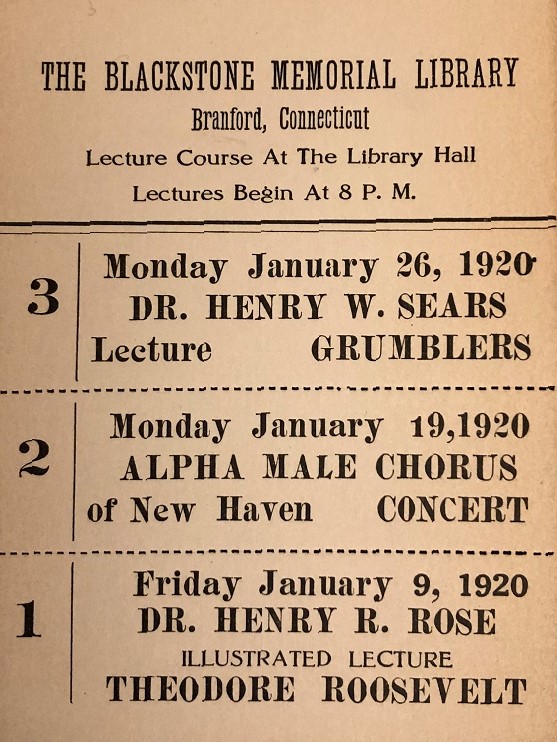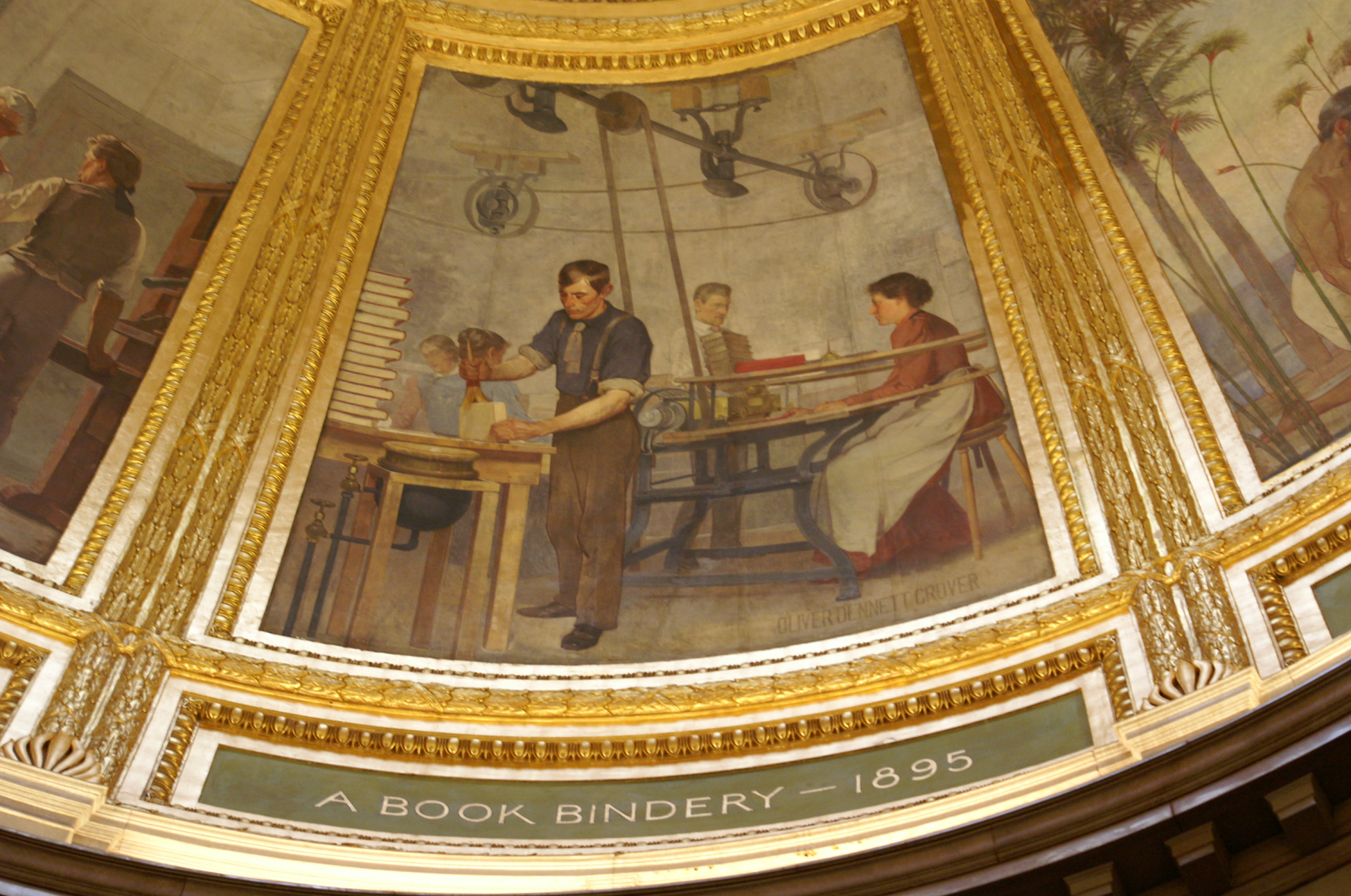
Are you ready to learn more about our gorgeous dome murals? For todays 125th Anniversary fact we’re sharing a description of panels seven and eight from the artist himself – Oliver Dennett Grover. But you can learn even more about these amazing paintings, and the artist who painted them, at our talk The Art of Blackstone Library on Saturday, April 9th at 2:00pm.
The scene of the seventh picture is laid in America and supposes a printing room in which two men dressed in the costume of Colonial times are operating what is known as the “Franklin Press,” an improvement on the old-time machines of Gutenberg and his contemporaries.
In front of the low broad window at the back of the room is seated a man at a table correcting proof and in the foreground lies a pile of books. The strong daylight from the partially draped window touching only the outlines of the figures, throws them in strong relief against the warm grey of the background, and a glimpse of sunny sky and trees seen through the small panes, gives a strong note of light and color to the scene.
The eighth and last picture deals entirely with that part of book-making which may be and often does amount to a fine art in itself. But the dress of most modern books is put on amid the buzzing of wheels and the clicking of machinery. Such a bindery is here represented as far as the artistic necessities would permit realistic representation.
Shafts, pulleys and belts, steam and electricity would hardly seem hopeful materials from which to build a decorative composition, but a careful adjustment of tones and arrangement of lines, together with its pictorial illustration of the subject, “A Book Bindery – 1895,” brings it into harmony with its neighbors and makes it a fitting ending to the series.
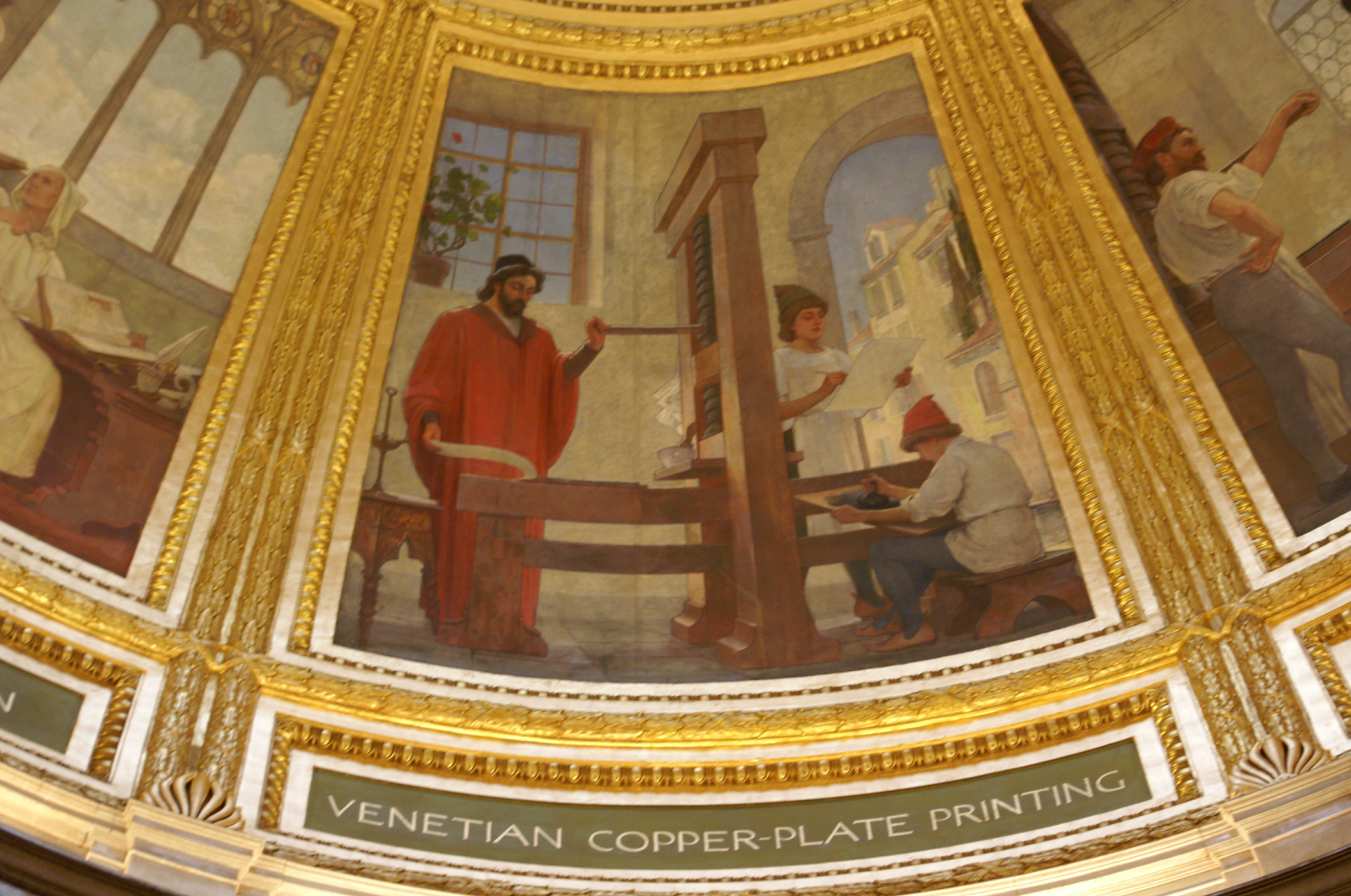
Are you ready to learn more about our gorgeous dome murals? For todays 125th Anniversary fact we’re sharing a description of panels five and six from the artist himself – Oliver Dennett Grover. But you can learn even more about these amazing paintings, and the artist who painted them, at our talk The Art of Blackstone Library on Saturday, April 9th at 2:00pm.
In “Venetian Copper-plate Printing” is shown the beginning of the modern tendency towards mechanical reproduction. In comparison with ancient methods it was an extremely rapid and labor-saving way of working. Printing from engraved or etched plates with the clumsy hand press was very early brought to a high state of perfection and for certain kinds of work has never been superseded, nor indeed materially improved upon.
The next important point in the development of the book is taken to be the introduction of movable type, and the sixth panel “First Proof – Gutenberg Bible” supposes the instant when the German inventor, Gutenberg, inspects the first proof of the now famous Gutenberg Bible as it is handed him by his assistant. His interest and anxiety is shared by the wife who stands at his side, and who, it may be believed, was equally anxious with him for the success of the undertaking. The picturesque garb of the time and the quaint details of the interior give local color and artistic life to the composition.
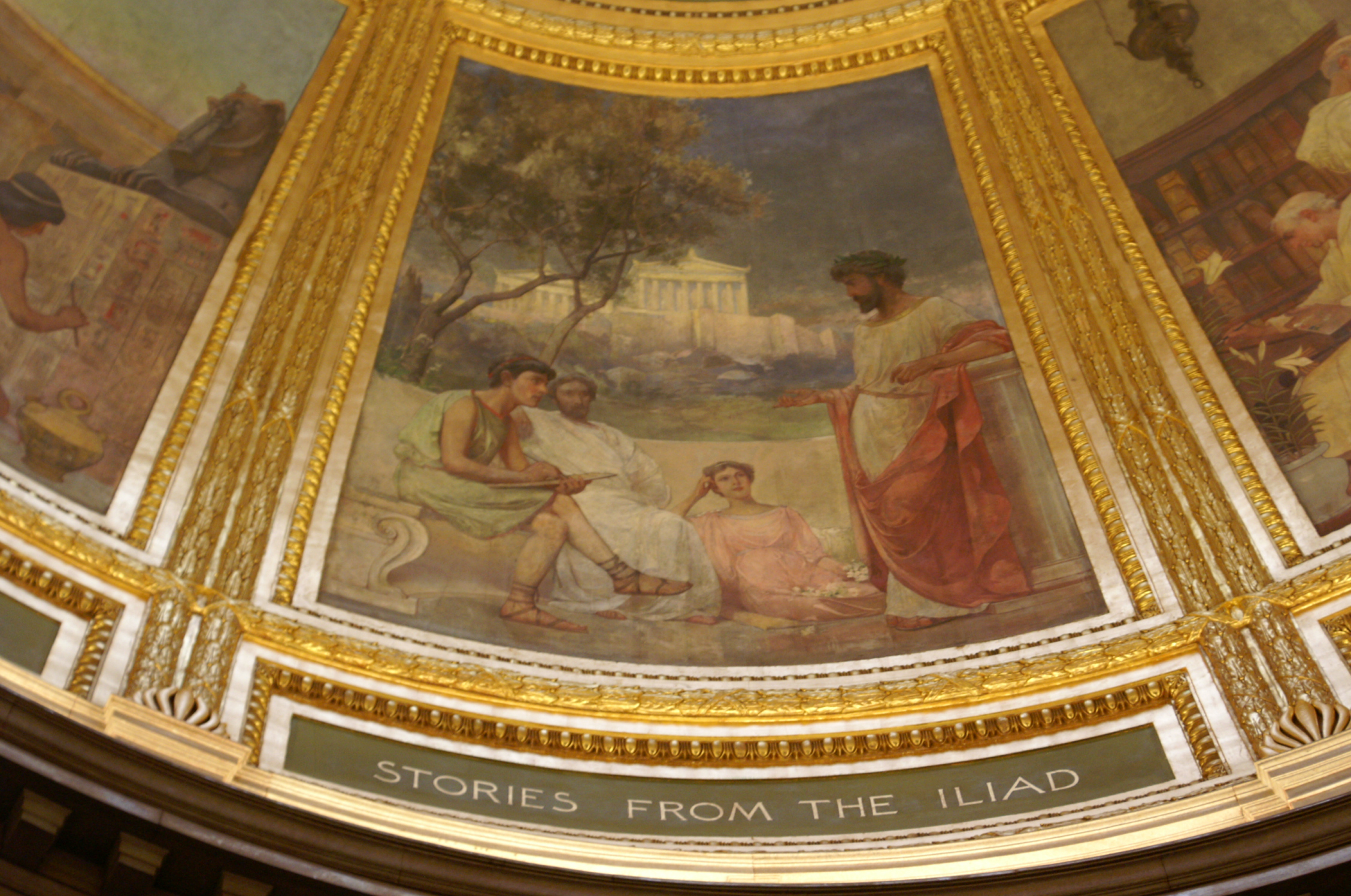
Are you ready to learn more about our gorgeous dome murals? For todays 125th Anniversary fact we’re sharing a description of panels three and four from the artist himself – Oliver Dennett Grover. But you can learn even more about these amazing paintings, and the artist who painted them, at our talk The Art of Blackstone Library on Saturday, April 9th at 2:00pm.
Number three, “Stories of the Iliad,” carries us from the land of the lotus to the shadow of the Acropolis. In the land of the ancient Greek those legends and stories finally gathered together and preserved to us by Homer in the form of the Iliad were for ages almost sung by wandering minstrels; committed to memory and transmitted from one to another, from father to son, from generation to generation.
The incident taken to illustrate this period of literary development is that of a minstrel reciting to an interested group of listeners “Stories from the Iliad,” while one of them, a Greek youth with stylus and tablet, is transcribing to enduring form the words as they fall from his lips.
In “Mediæval Illumination” is illustrated the illumination of books by white-robed monks. In the soft tones of the picture and the quiet earnestness of the three figures are suggested the infinite patience of those who, counting time as naught in living for eternity, left the world richer than they found it by the exquisite art which, in passing, paved the way for much that is best in what followed it.
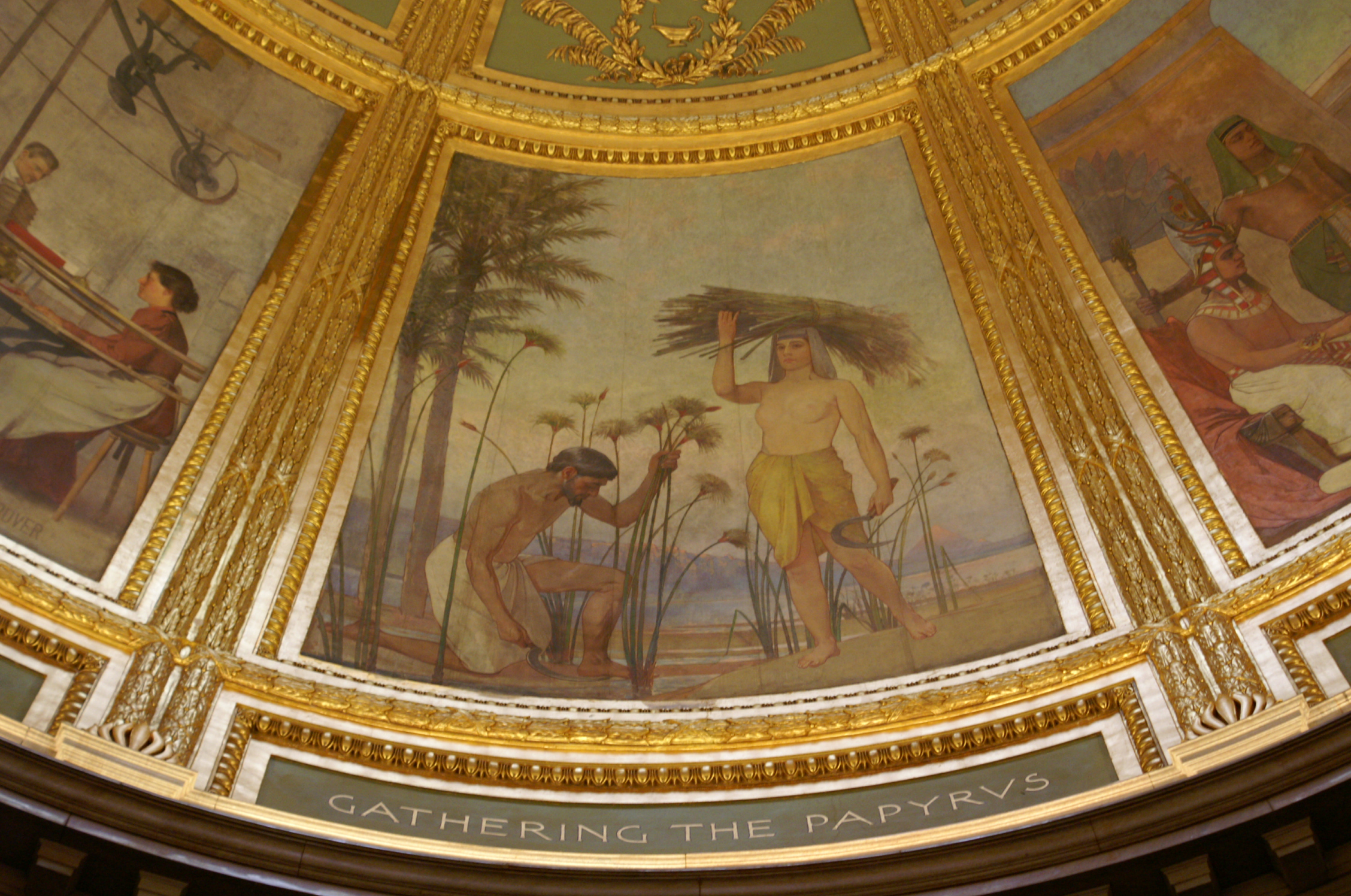
It’s an exciting time here at the Blackstone! Our spring calendar is officially under way, which means the programs celebrating our 125th Anniversary are finally here! One of those special events is a visit from Joel Dryer all the way from Chicago on Saturday, April 9th. Who is Mr. Dryer? He’s the official biographer of Oliver Dennett Grover, the artist who painted our incredible dome! Mr. Dryer will be sharing all kinds of information about the man responsible for one of our biggest WOW factors here at JBML, and in order to get you all excited for his visit, we’ll be featuring up close looks at those amazing panels over the next few weeks. Today we’re featuring panels one and two, complete with descriptions from the artist himself:
In the decorations of the dome it is designed to illustrate pictorially and in a decorative way the evolution of book-making. The first step in this direction is presumed to be the gathering of Egyptian papyrus with a view to providing materials for scroll inscriptions, which may be regarded as the primitive book-making of the earliest time. This first picture of the series of eight is entitled “Gathering the Papyrus.”
The palm, the tall heavy reeds and the simply attired figures in the foreground show almost in silhouette against a warm sky and the reflecting surface of the river at the back, while in the distance rising from the level plain are pyramids tipped with gold by the rays of the declining sun.
“Records of the Pharaohs,” the second of the series and also Egyptian, shows another phase of that civilization in the massive architecture, the emblematic ornamentation, the calm dignity and consciousness of power of the dominant race.
The picture represents an officer of the court of Pharaoh with an attendant guard by his side dictating from a papyrus roll which lies open across his knees, to a worker who is transferring the records to the base of a monument. While in this panel sufficient license has been taken to preserve the artistic harmony and decorative composition, the detail of character, costume, ornament and architecture is carefully studied and accurately rendered from correct and acknowledged authorities.
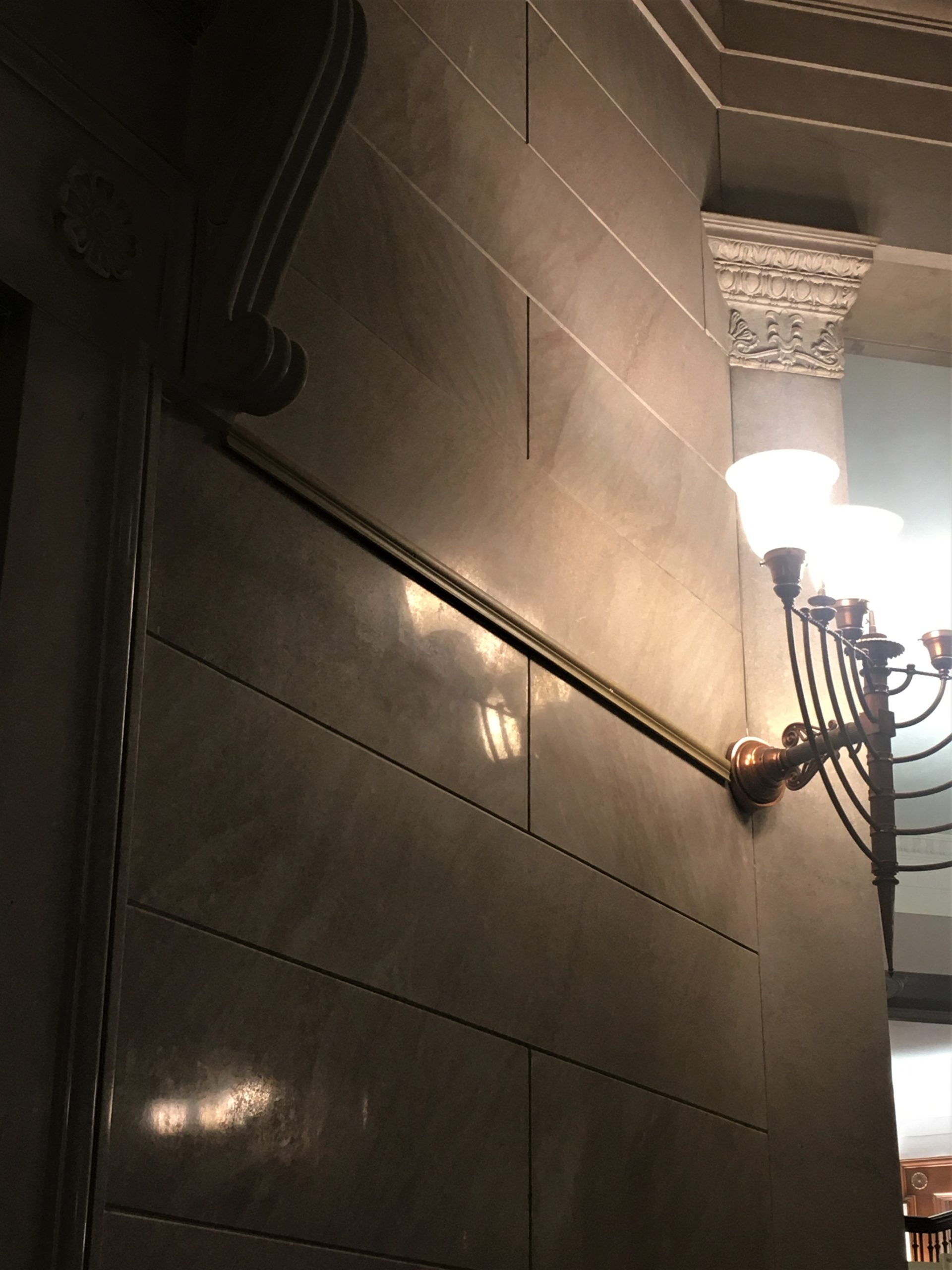
Today’s 125th Anniversary Fact is picture perfect! Have you ever wondered what the gold strip between the lights of the rotunda was for? It has nothing to do with the lighting, and is in fact a very old piece of technology that was added to the library long after it fell out of use more generally. Any ideas? No?…It’s a picture rail! Picture rails were a common feature on buildings with plaster walls. Plaster was expensive and difficult to repair, so one had to be very sure when hanging something on the wall. Enter the picture rail. These rails went around the outside of a room, and are not flush to the wall. This allows for pictures to be hung from hooks attached to the rail rather than hanging them directly onto the plaster walls. The rotunda did not have a picture rail in the initial construction, but this one was installed within the last 20 years to make hanging artwork in the rotunda feasible. Marble is even more difficult to hang artwork from than plaster, so although picture rails are out of fashion, this turn of the century technology suits the space in more ways than one!
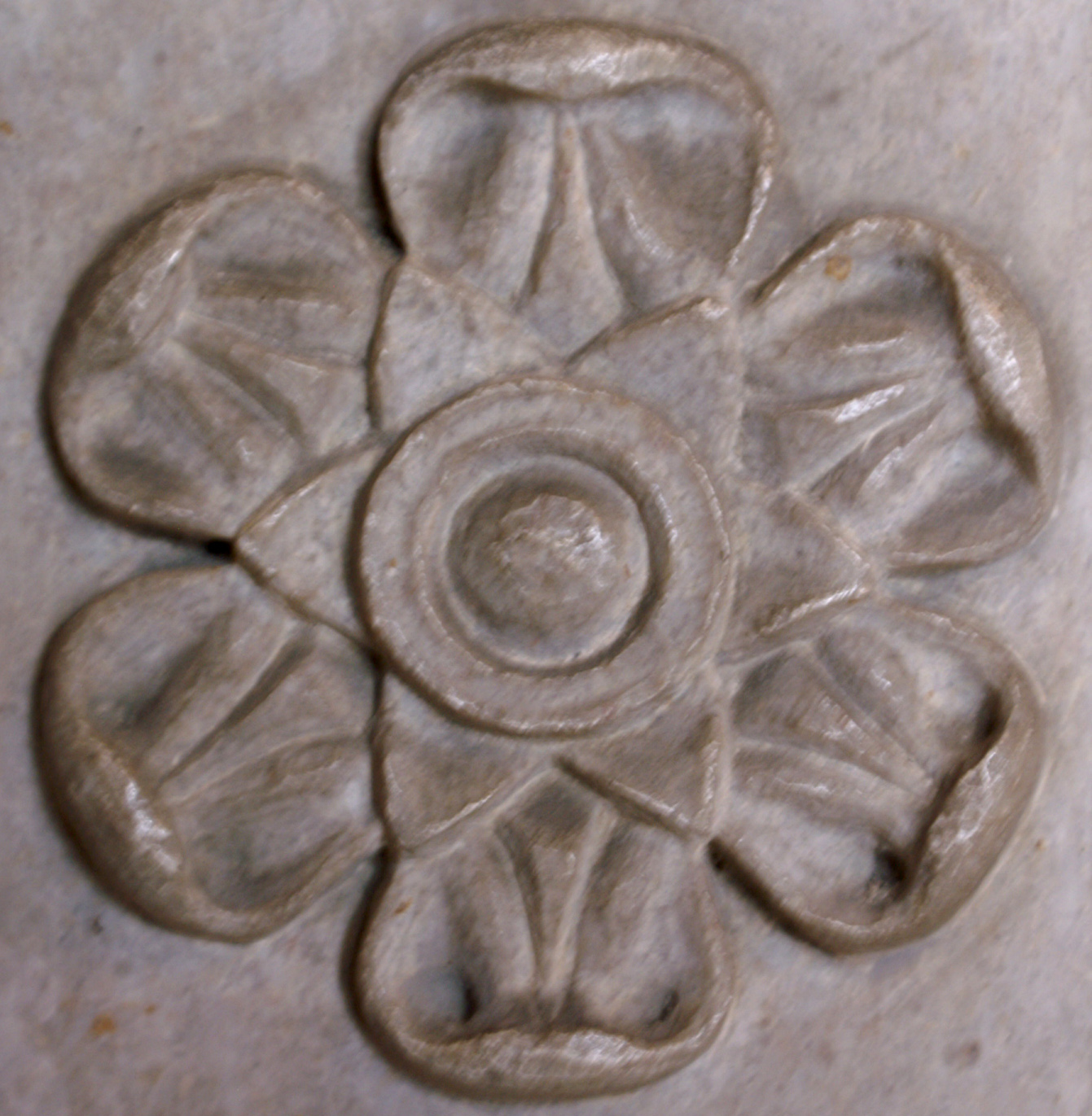
Are you ready to learn about another architectural detail of the Blackstone Library? For today’s 125th Anniversary Fact, we’re sharing what is by far the most common motif sprinkled throughout the library. The library is home to hundreds of rosettes in marble, wood, and metal, but what exactly is the humble rosette? A rosette is a round, stylized flower design, used extensively in sculptural objects from antiquity, appearing in Mesopotamia and used to decorate the funeral sites in Ancient Greece. It was adopted later in Romanesque and Renaissance, and also common in the art of Central Asia, spreading as far as India where it is used as a decorative motif in Greco-Buddhist art. Since the library is modeled on the Greek Erechtheion (Temple of Athena), it makes sense that the building would feature an architectural detail so popular with the Greeks, as well as the rest of the ancient world. The next time you’re at the Blackstone, see how many you can find!

It’s Valentine’s Day which is the perfect day for celebrating the special people in your life. That’s why for today’s 125th Anniversary Fact we’re celebrating some of the most important people in Blackstone’s history–the men who built the library! We’re lucky enough to have a photo of the original construction crew taken on the front steps of the library back in 1896, each holding the tools of his trade. They worked for Probst Construction Company, the firm that built the library. They had offices in both Chicago and Branford (according to their business card) which must have made them the ideal team to build a library in Branford, designed and funded in Chicago. It’s truly remarkable the building was built by such a small crew, and we wish we knew more about these incredible craftsmen. Our best guess, judging by the tools they’re holding, is carpenters on the right, stone workers on the left, and possibly engineers and the foreman in the center.
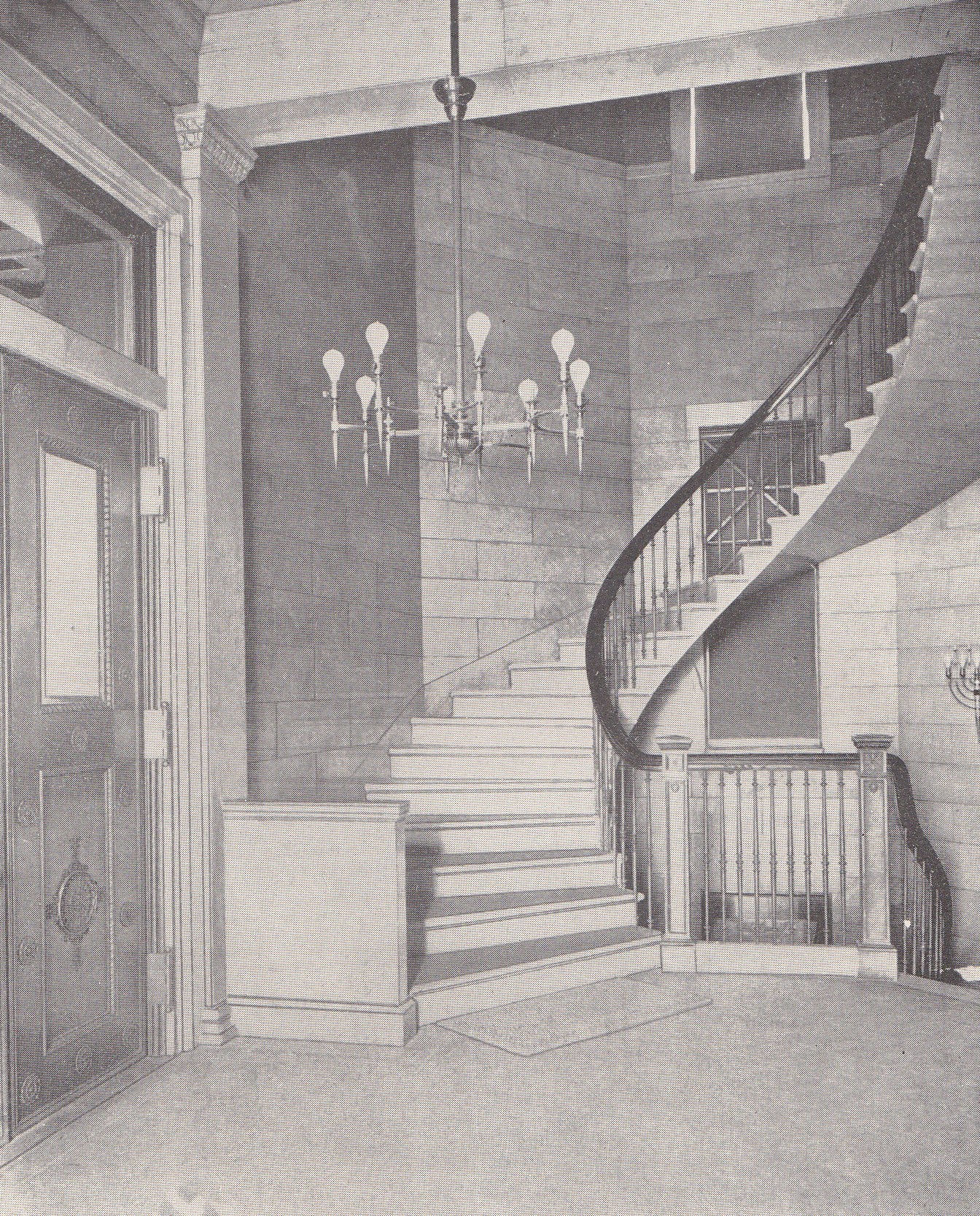
Today’s 125th Anniversary Fact is all about an architectural feature that will send you spiraling with delight! Everyone knows our marble spiral staircase is one of the most impressive features of the library, but have you ever wondered how it stays up while seeming to float in the air? We have physics to thank for its sturdy and beautiful construction.
Our staircase is known as a cantilever staircase, which means it is anchored on only one side. The key to its stability comes from the fact that each stair supports the weight of the stairs above it, while also being supported by the stairs below. The portion embedded into the wall prevents the stair from twisting under the weight, which makes for a very stable design. The spiral shape of the stairs also helps reduce the risk of an individual stair twisting (decreases torsion) which makes for an even more secure staircase. It’s a true marriage of form and function!
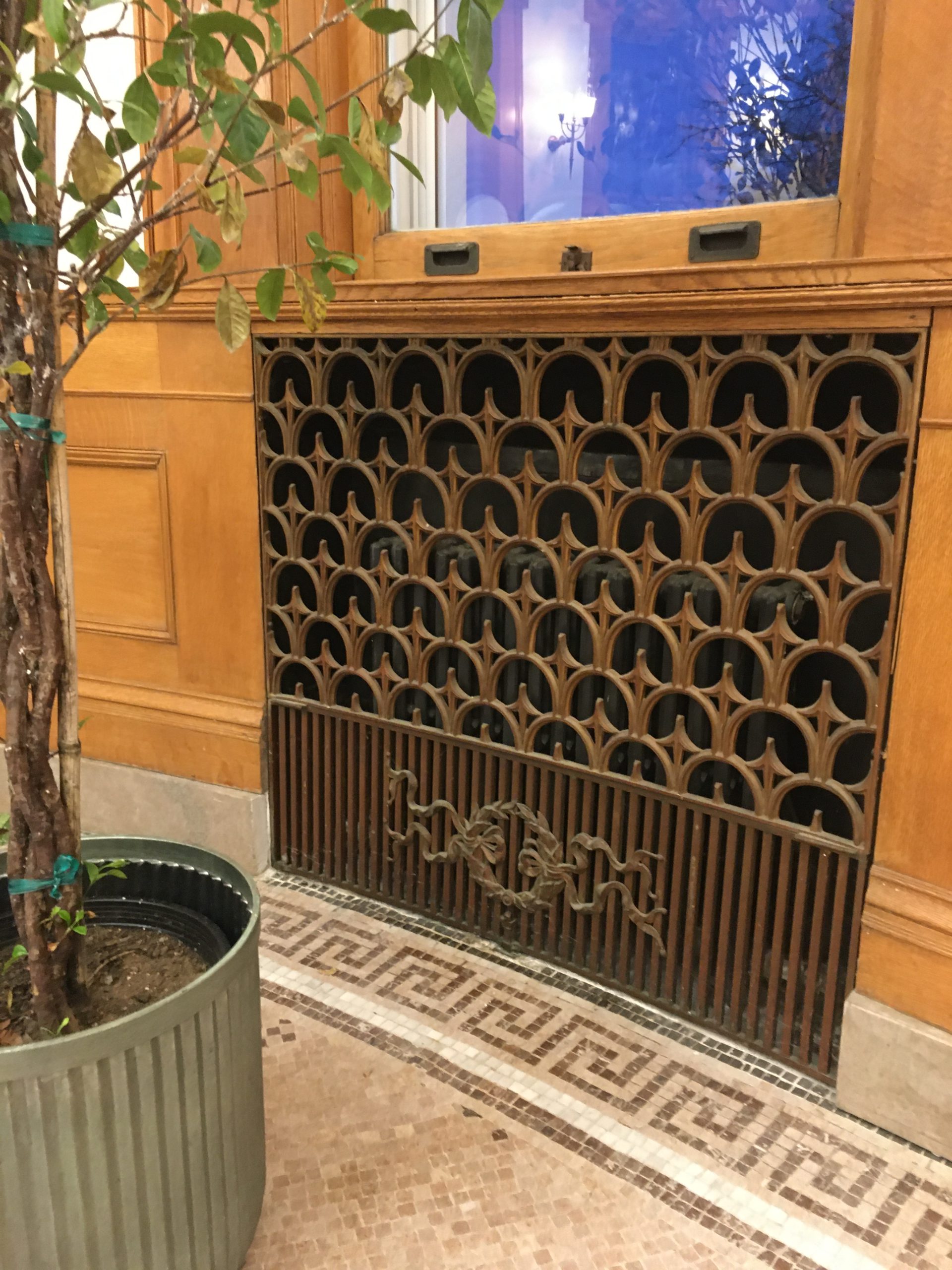
The temperature keeps dropping, but thankfully the Blackstone Library and today’s 125th Anniversary Fact are nice and toasty! While the majority of our heating has been modernized, some of the original radiators are still warming the library after 125 years. The ones in the floors and those that line the rotunda have been decommissioned for quite some time, but the largest grates in the Reading Room and Café are still covering working radiators. If you’re looking for a cozy (and stunning!) place to get some work done, be sure to snag a table by one of the wall grates!
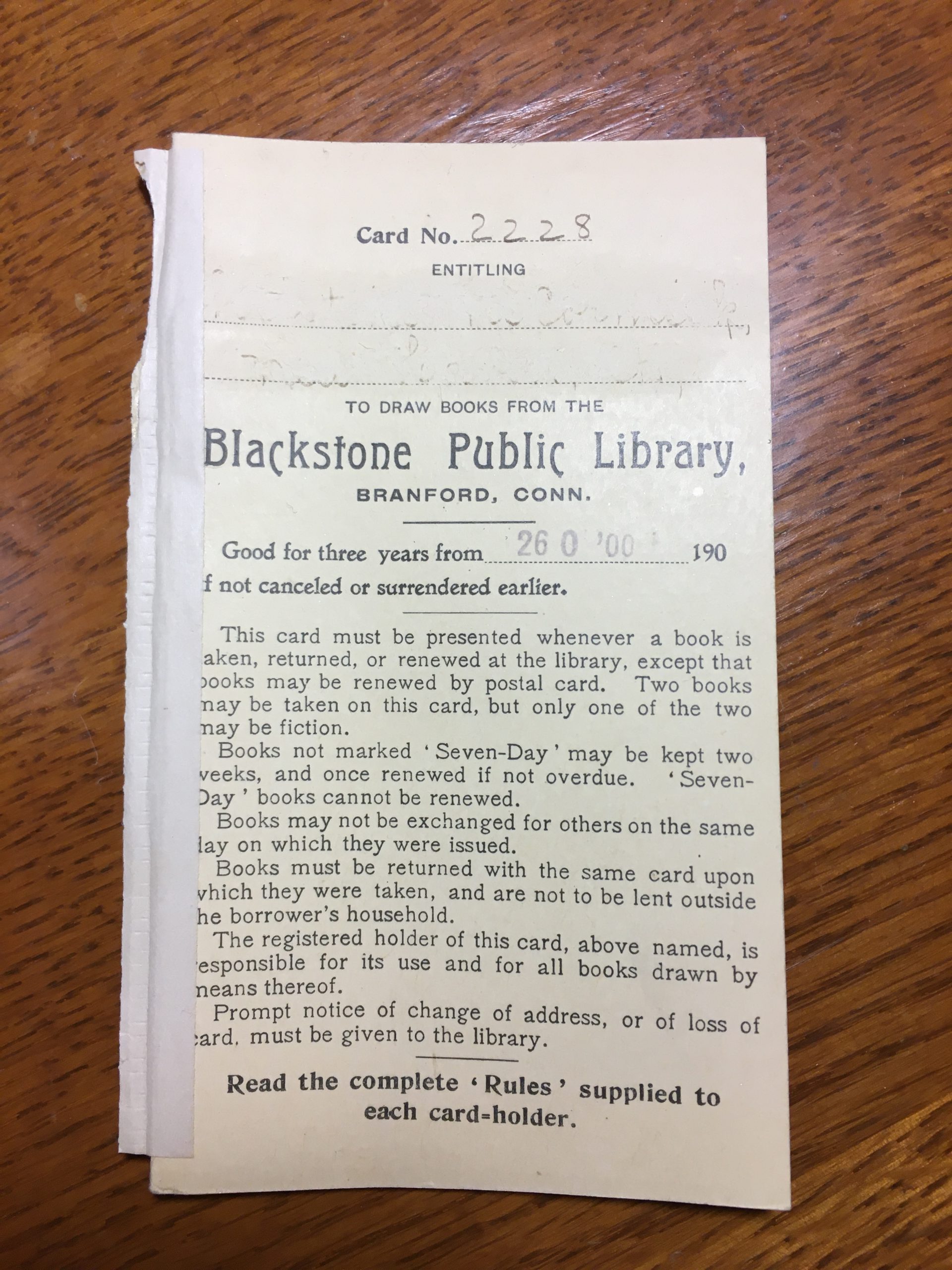
Library users love the convenience of modern library cards. They fit in your wallet, on your keys, even in your smartphone! But have you ever wondered what a library card used to look like? For today’s 125th Anniversary Fact we’re going to show you! This library card dates from around 1900 and was recently found in one of our scrapbooks. It’s more of a pamphlet then a card, and it has spaces to record when a book was loaned and when it was returned. It also includes a list of rules on the front, some familiar, some thankfully a thing of the past! We know our patrons would not appreciate us limiting them to two books, especially if “only one of the two may be fiction.” Harsh!
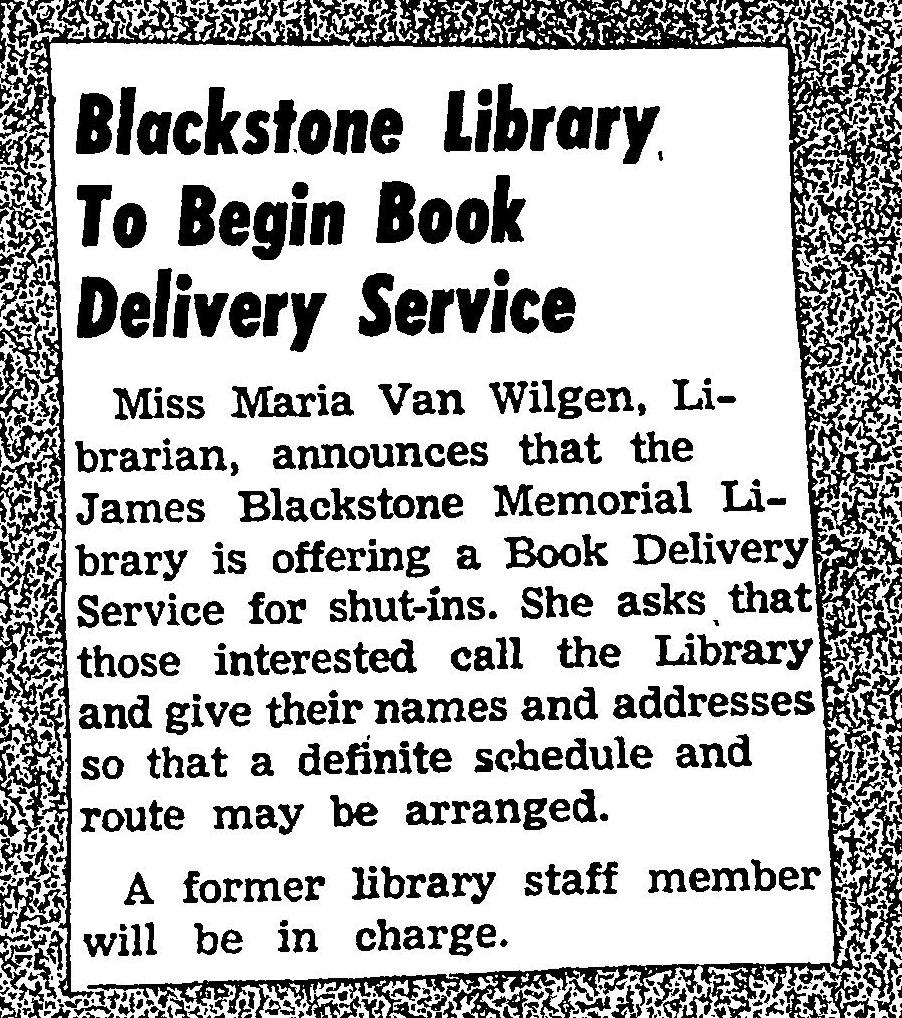
The Blackstone Library offers a wide variety of services to the people of Branford and while the services we offer change with the needs of our community, one of our most popular services recently turned 54 years old! That’s why for today’s 125th Anniversary Fact, we’re celebrating our Homebound Delivery Service. This special delivery service debuted in November of 1968 and was designed to provide books and other library materials to community members who were confined to their homes. Over the years, deliveries have been made by both librarians and volunteers, and today SARAH Inc. delivers books, audiobooks, and other materials twice a month to our current group of homebound patrons. Do you know someone who can’t leave their home, either permanently or temporarily, who could benefit from book deliveries? Give us a call in the Reference Department to learn more! (203) 488-1441 ext. 318.
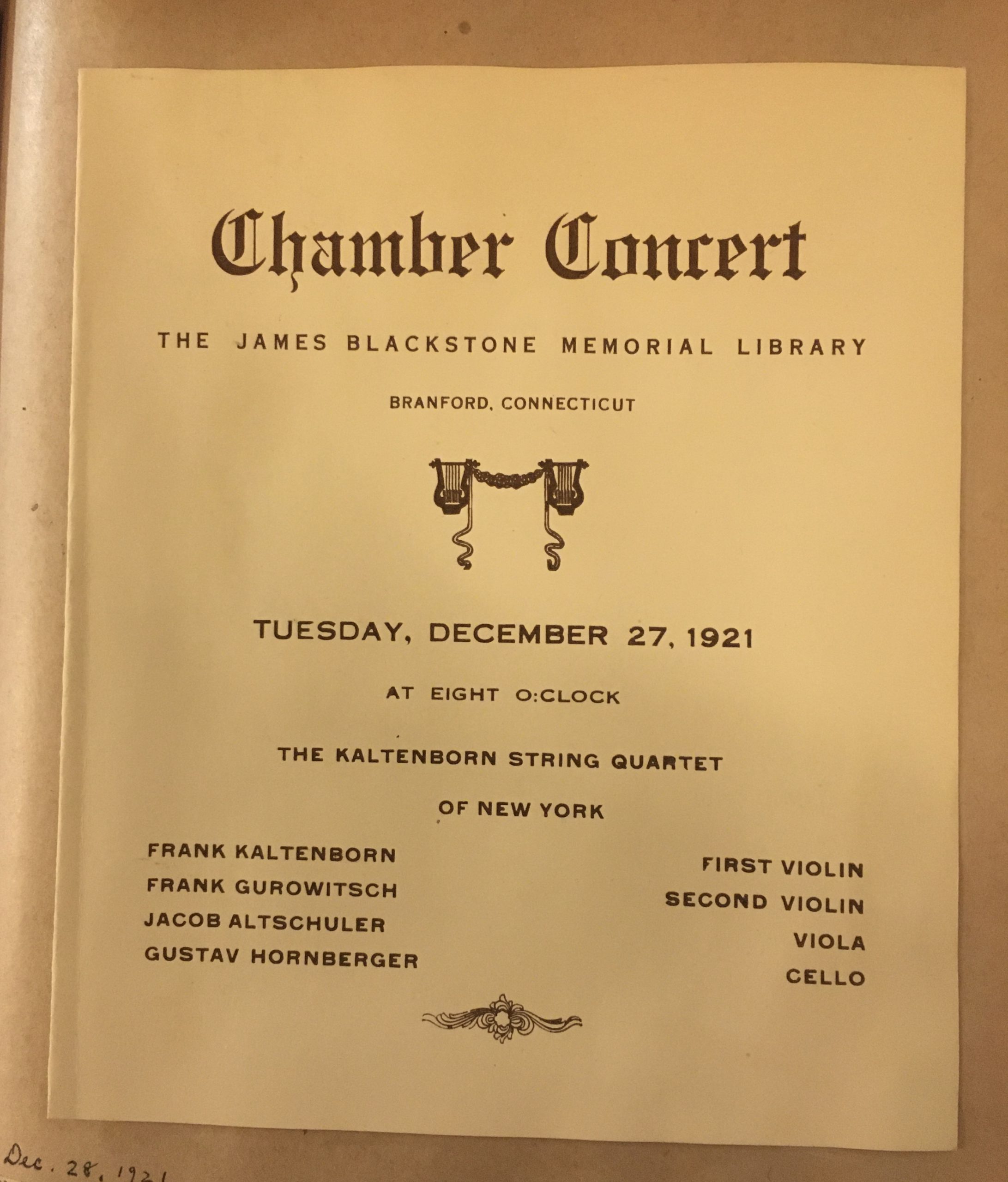
As we celebrate the start of a new year, what better time to reflect on the past and look forward to a fresh start in the new year to come? For today’s 125th Anniversary Fact, we decided to take a peek into the past (100 years to be exact) to December 27th, 1921 to see exactly what we were up to all those years ago. According to our archive of library scrapbooks, we were presenting a chamber concert by The Kaltenborn String Quartet of New York. Want to really connect with the past and feel like you’re stepping back in time? The Library of Congress has a recording of the quartet on their website, so you can really party like it’s 1921!
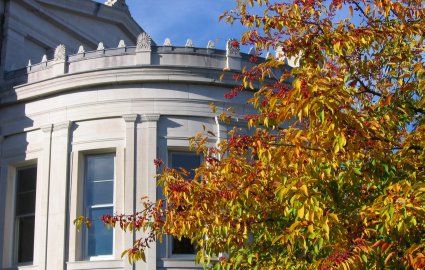
For today’s 125th Anniversary Fact we’re sharing another subtle architectural detail of the Blackstone Library you may not be aware of. You’re probably familiar with our circular reading room, but did you know even the windows are curved to fit the space? It’s no optical illusion! Curved glass is often found in buildings dating from the 1890s, and creating it is a challenging process even today. A steel mold with the correct curvature must first be created and heated, and the straight pane of glass must be inspected for flaws that may cause it to shatter in the kiln. The glass is then coated in a mixture of calcium carbonate and detergent to prevent it from sticking to the steel mold. Once the glass is fully coated, it is placed on the heated steel mold and loaded into the kiln. The glass must reach about 700 degrees before it begins to melt and bend to the desired shape, and then the kiln is slowly cooled. Now imagine doing all that in 1896!
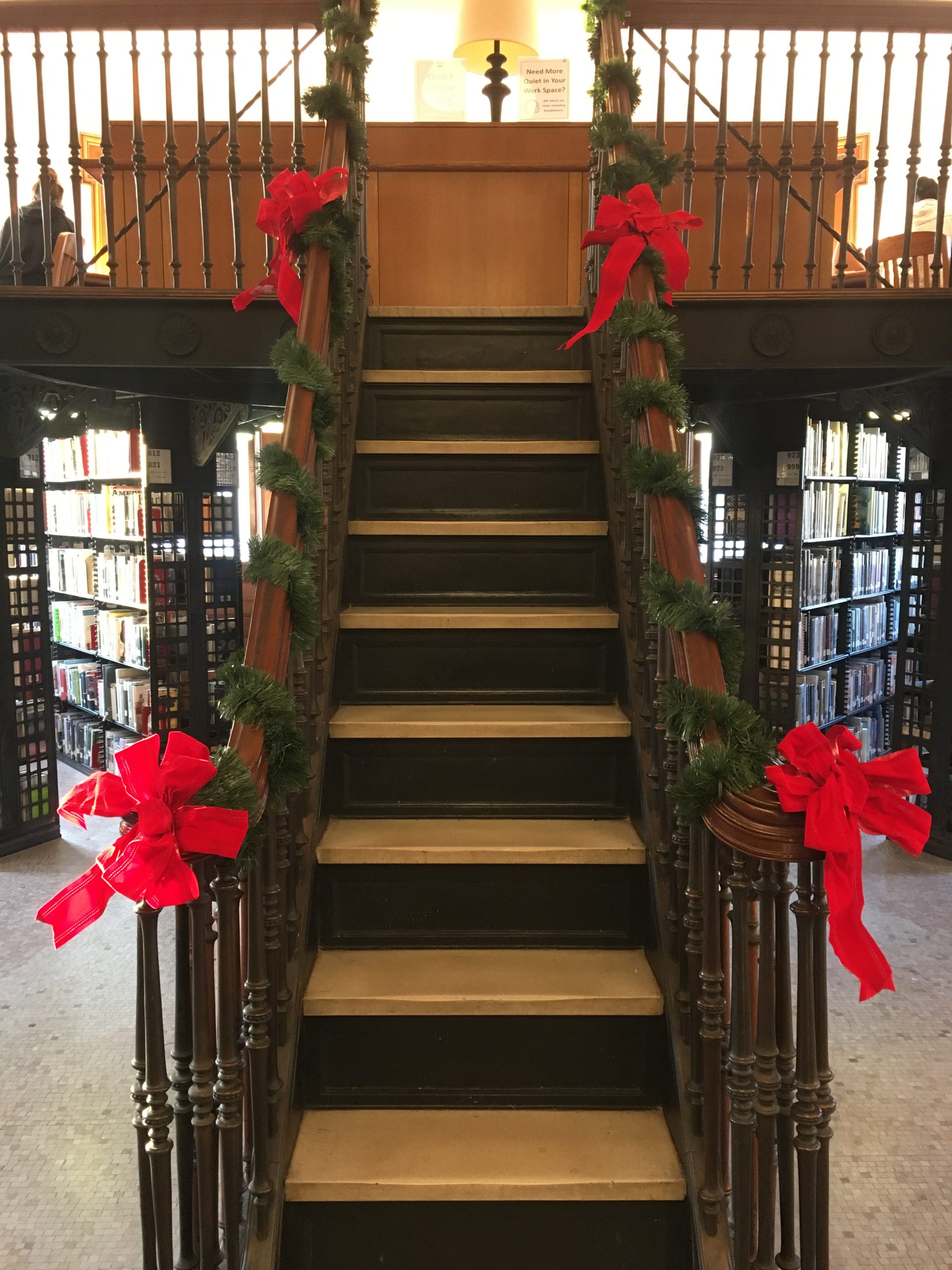
If you’ve visited the Blackstone in the last few weeks, you’re sure to have noticed that the library halls are thoroughly decked for the holiday season! But do you know who’s responsible for all this festive cheer? It’s not the library staff that makes it happen–it’s all thanks to the Branford Garden Club! Those fantastic planters on our front steps were also generously donated by them, and they make our main entrance even more spectacular year-round. The Blackstone has partnered with the Garden Club for decades, hosting lectures and classes sponsored by the group going back to at least the 1930s. We love partnering with local institutions in town and helping them reach a wider audience–it’s a win-win-win for the library, the group, and the people of Branford. We also partner with groups like the Branford Historical Society, Branford Forum, the Land Trust, the Senior Center, Shoreline Adult Education, and more! If you’re looking to find your people, our calendar has always been a good place to start!
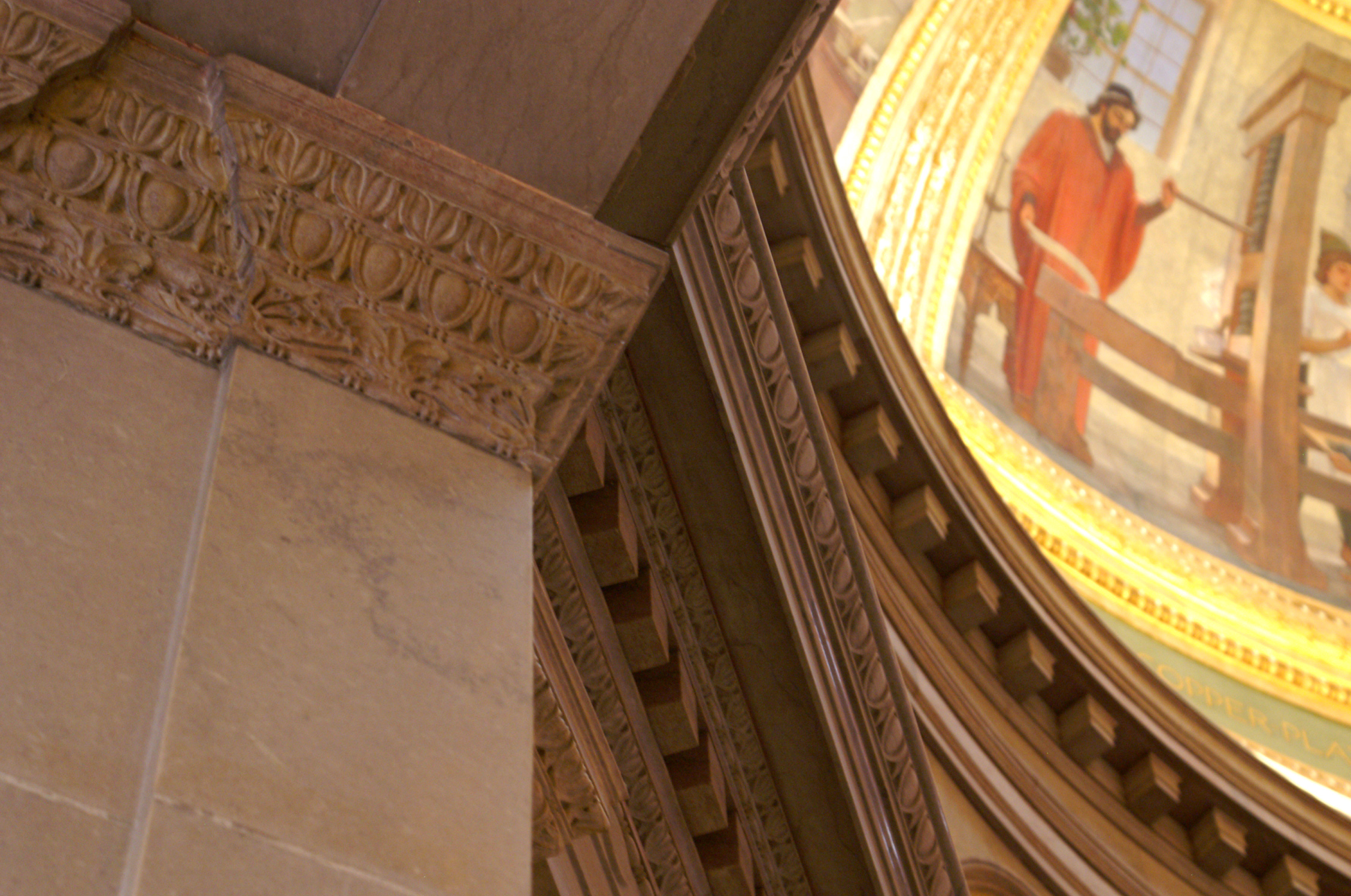
We always love when patrons marvel at our architecture! It’s a great reminder for everyone on staff to take a step back and look up in admiration at the amazing achievements of our library’s builders, so we thought we’d share some of those marvel-worthy details with you for today’s 125th Anniversary Fact.
The paintings in the library dome are certainly show stopping, but have you ever looked closely at the marble details that surround them? Today’s photo showcases two of the most prominent details carved into the marble–the Egg-and-Dart motif and Dentils. Egg-and-Dart is typically an egg-shaped object alternating with a V-shaped element which dates back to Ancient Greek architecture and is all over the building. It’s well represented in marble here, but also makes appearances in the library in wood and plaster. In fact, some of our original plaster Egg-and-Dart suffered water damage over the years and was finally repaired with our most recent renovation. Master Plasterer may not be a common career, but we’re grateful they’re still around to help maintain buildings like ours!
If the Dentil makes you think of teeth, you’re on the right track! The name comes from the same Latin word that gives us Dental and Dentist (dens which means tooth). Dentils are tooth-like blocks in rows that often accompany Egg-and-Dart, and both were very common motifs around the time the library was built. Both of these little architectural details date back to Ancient Greece, and both appear on the Erechtheion, the Ancient Greek temple which the library is modeled after.
Photo courtesy of Jason Neely
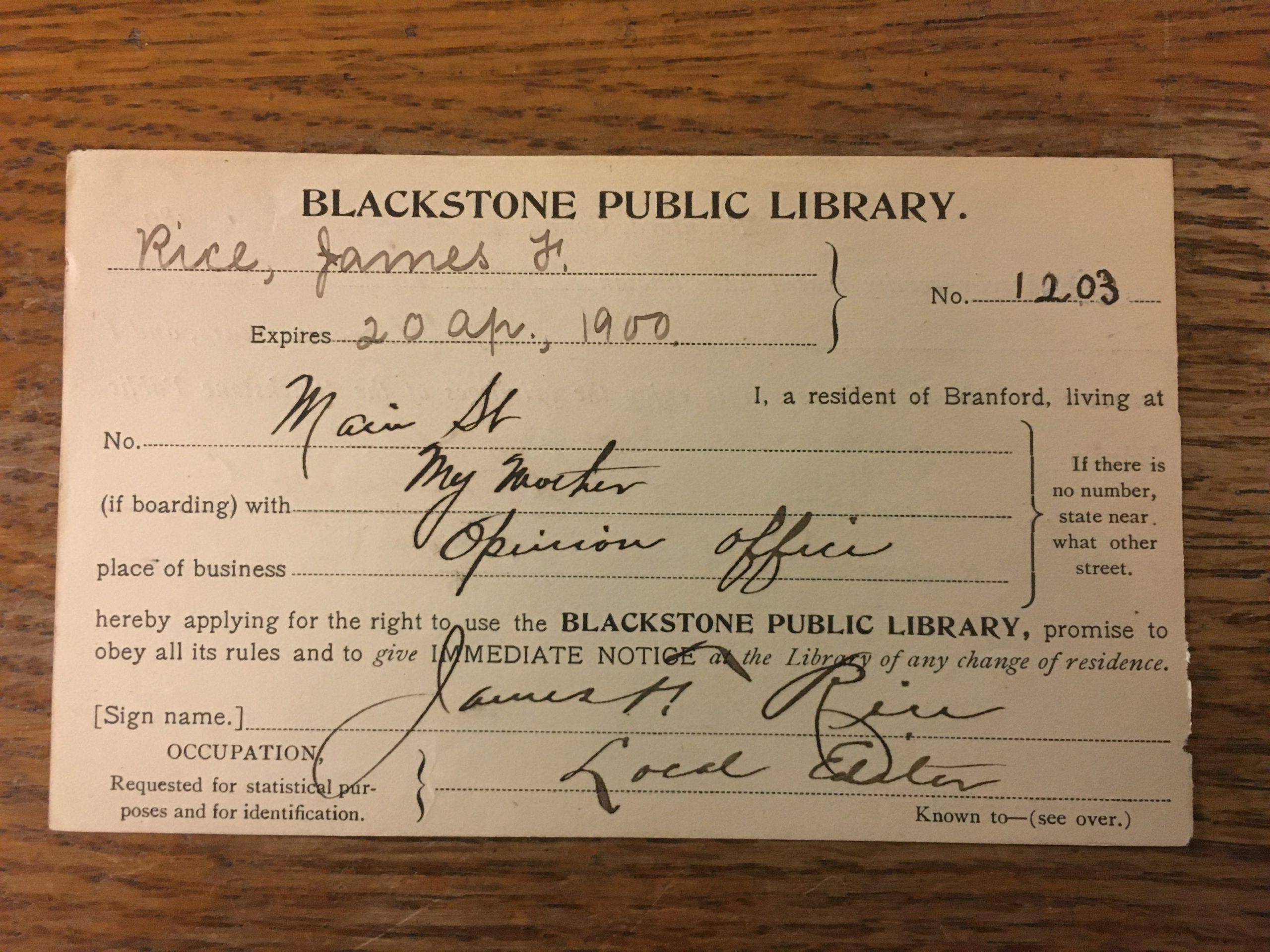
The upcoming Thanksgiving holiday has the Blackstone Library thinking about families and how important they can be. Spending time with loved ones (in person or virtually) over the holidays gives us an opportunity to learn more about them and can remind us how their experiences have shaped our own lives. That’s why today’s 125th Anniversary Fact is all about a family history resource that’s totally unique to Branford and the Blackstone Library.
In our archives we’ve saved hundreds of paper library card applications dating back to 1896. These cards were maintained until approximately the 1970s, and were how librarians tracked information about library patrons in the days before computers. That may not sound very impressive, but we’re sure the local genealogists are already getting excited! What information is preserved on these cards? It’s more than just names and addresses. We also asked questions about occupation, living situation, and place of business. If you were a child, we asked what school you went to. In the early days someone in town had to “recommend you” in order for you to get a library card, so we can learn all kinds of things about relationships between friends and neighbors. These cards also exist for summer residents, so we have information on people from New York, Massachusetts, and other areas in Connecticut. When someone passed away, it was recorded on their library card application and any notable circumstances were recorded–for example we have several cards that mention a young male cardholder “died in war” in the 1940s.
These cards are chock full of hints about the lives of the people who came before us. Anyone who has researched their family history knows just how important little hints can be in uncovering big discoveries! Not to mention there’s something special about seeing the handwriting of a relative who is no longer with us. We’re working on the monumental task of digitizing and indexing these cards, and hope to make their information available to the public sometime in the near future so be sure to keep an eye on our online local history pages!
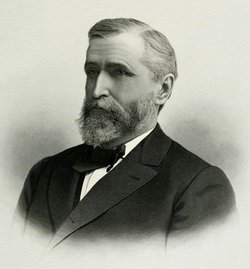
For today’s 125th Anniversary fact we’re taking a look at the man behind the funding of the library. Timothy Blackstone’s generosity is the reason we have such an incredible library in Branford, but how much do you really know about him? Read on to learn all about the man behind the library!
Timothy Beach Blackstone (March 28, 1829 – May 26, 1900) was a railroad executive, businessman, philanthropist, and politician. He is descended from William Blaxton, an early settler of New England. He worked in the railroad industry for most of his life after dropping out of school. At the time of his death, his estate was worth US$6 million ($186.6 million today).
Blackstone was born in Branford, Connecticut, the sixth child, and fourth son, of James Blackstone and Sarah Beach. Health issues caused Blackstone to drop out of school in 1847, and he began working for Roswell B. Mason, surveying the New York and New Haven Railroad (NY&NH). In 1851, Roswell he was invited to supervise construction of the Illinois Central Railroad between Bloomington and Dixon, Illinois. Blackstone accepted the job and moved to La Salle, Illinois.
Blackstone was elected mayor of LaSalle in 1854 and served a single term, his only foray into politics. After leaving office, he returned to working on railroads, first as chief engineer of the Joliet and Chicago Railroad, which would eventually become the Chicago and Alton Railroad.
In 1868, Blackstone married Isabella Farnsworth Norton, the daughter of a successful businessman from Norwich, Connecticut. Blackstone died of pneumonia on May 26, 1900, in Chicago, Illinois. His funeral was held at the Second Presbyterian Church and was then transported to Norwich, Connecticut for burial.
In addition to being the benefactor of our library, his widow donated the Blackstone Memorial Library to the Chicago Public Library in 1902, the first dedicated branch of the Chicago Public Library system. The Blackstones also funded Blackstone Hall for the Art Institute of Chicago Building, and his mansion became the site of the Blackstone Hotel and the Blackstone Theatre.
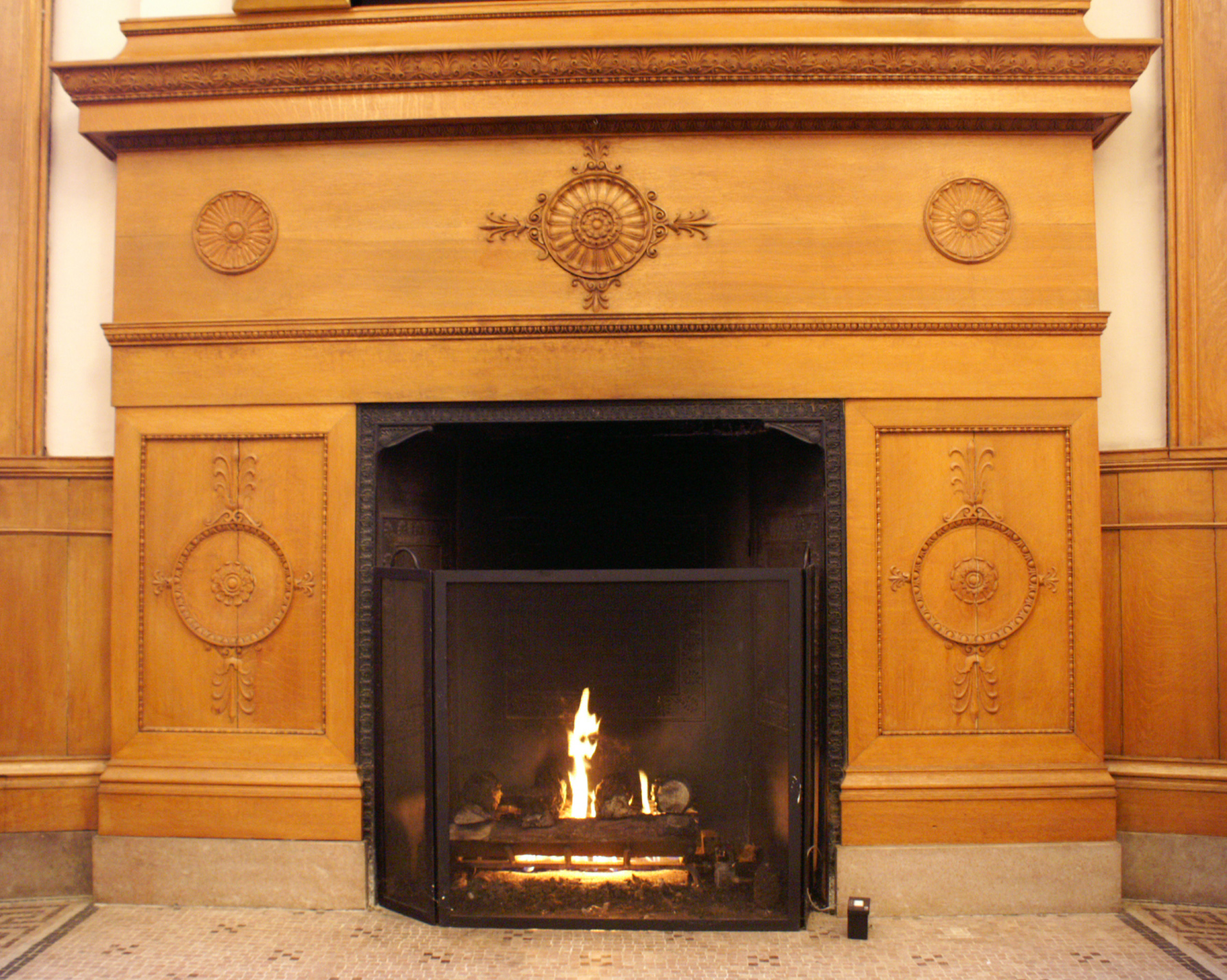
Today was an absolutely beautiful day, but the leaves on the trees are reminding us that fall is here at last! With the weather getting colder, we wanted to share an extra cozy 125th Anniversary Fact. Did you know that the fireplace in the Reading Room is more than just decorative? While it’s certainly an eye catching period detail, it’s also been retrofitted with all the modern conveniences and safety features. We light it every day during the late fall and winter, and it adds the perfect relaxing touch to a chilly morning reading the paper or getting some work done at the library. The next time you’re looking for somewhere to unwind with a good book or get some work done outside your home, be sure to check out the Reading Room at the Blackstone!
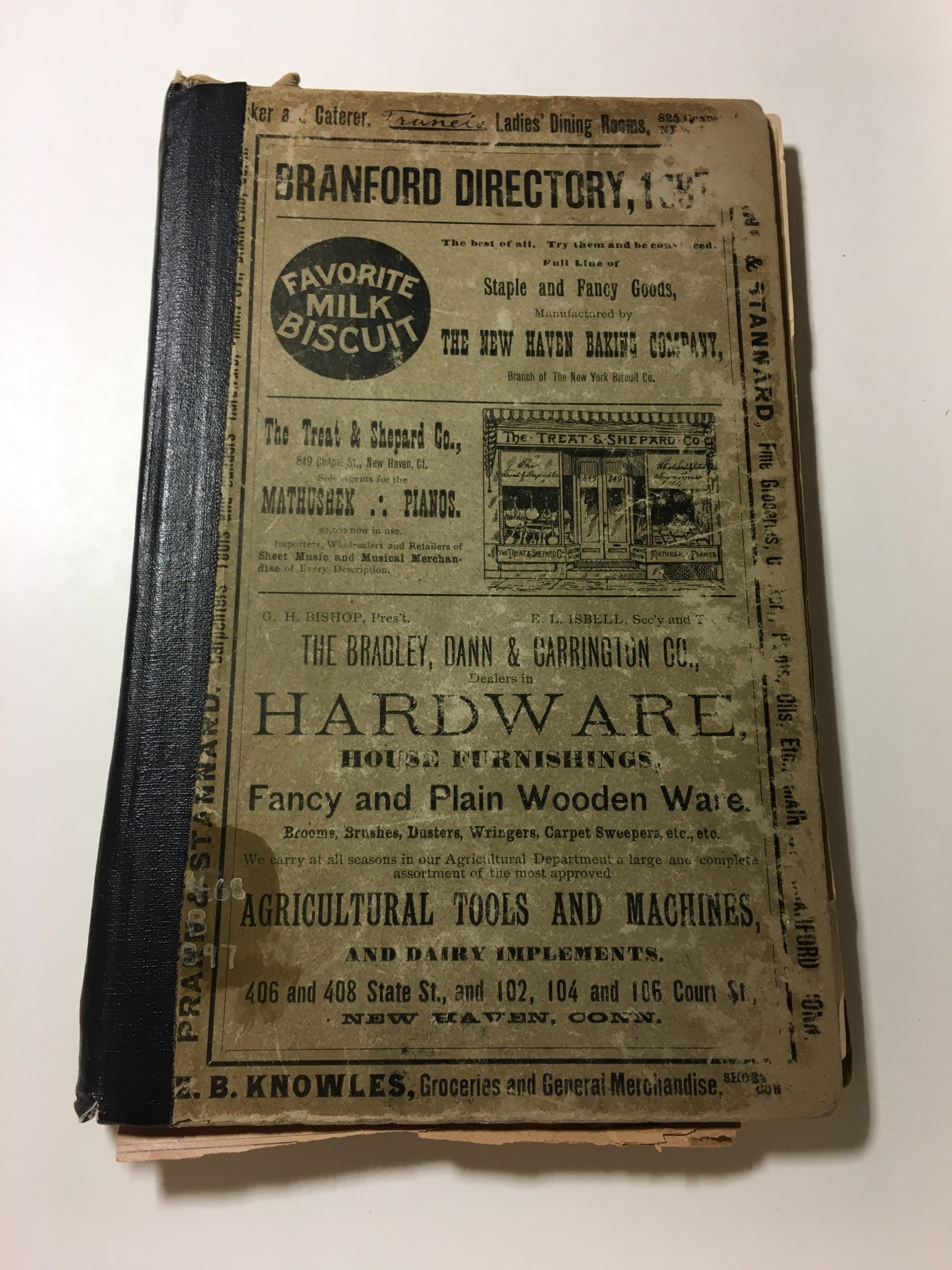
Many thousands of books have passed through the Blackstone Library’s collections over the years, but today we’re presenting you with one of the most special titles we own. It’s not the fanciest, not a classic or a best seller. It’s not the most valuable, the oldest book in the building, or even the first book we ever purchased. Today’s 125th Anniversary Fact is about the oldest recorded, continuously owned, book in the Blackstone Library’s collection–a monumental feat of endurance! It’s never been damaged beyond repair, lost, or needed to be replaced. For 124 years it has remained on the shelf for the people of Branford to use and enjoy. That book is…the 1897 Branford City Directory!
Some of you may remember our Accession Records from several Anniversary Facts ago. They are a running list of every title added to the collection dating back to 1897. This book is the first one listed in the earliest Accession Record book we have. Its internal book plate proclaims that it was added to the collection on the 29th of April in 1897, which matches the date in the Accession Records. Most importantly, the entry for the 1897 City Directory was never marked as “Condemned” — the word used to describe books that were removed from the collection for any reason. Every other title on the page was condemned, but not this little City Directory!
Now a part of our local history collection, the Branford City Directories are similar to phone books and list people and businesses located in town. They can be handy for genealogy, and are also just fun to look through. With the proper care and a little luck, this book should remain on the shelf for another 124 years.
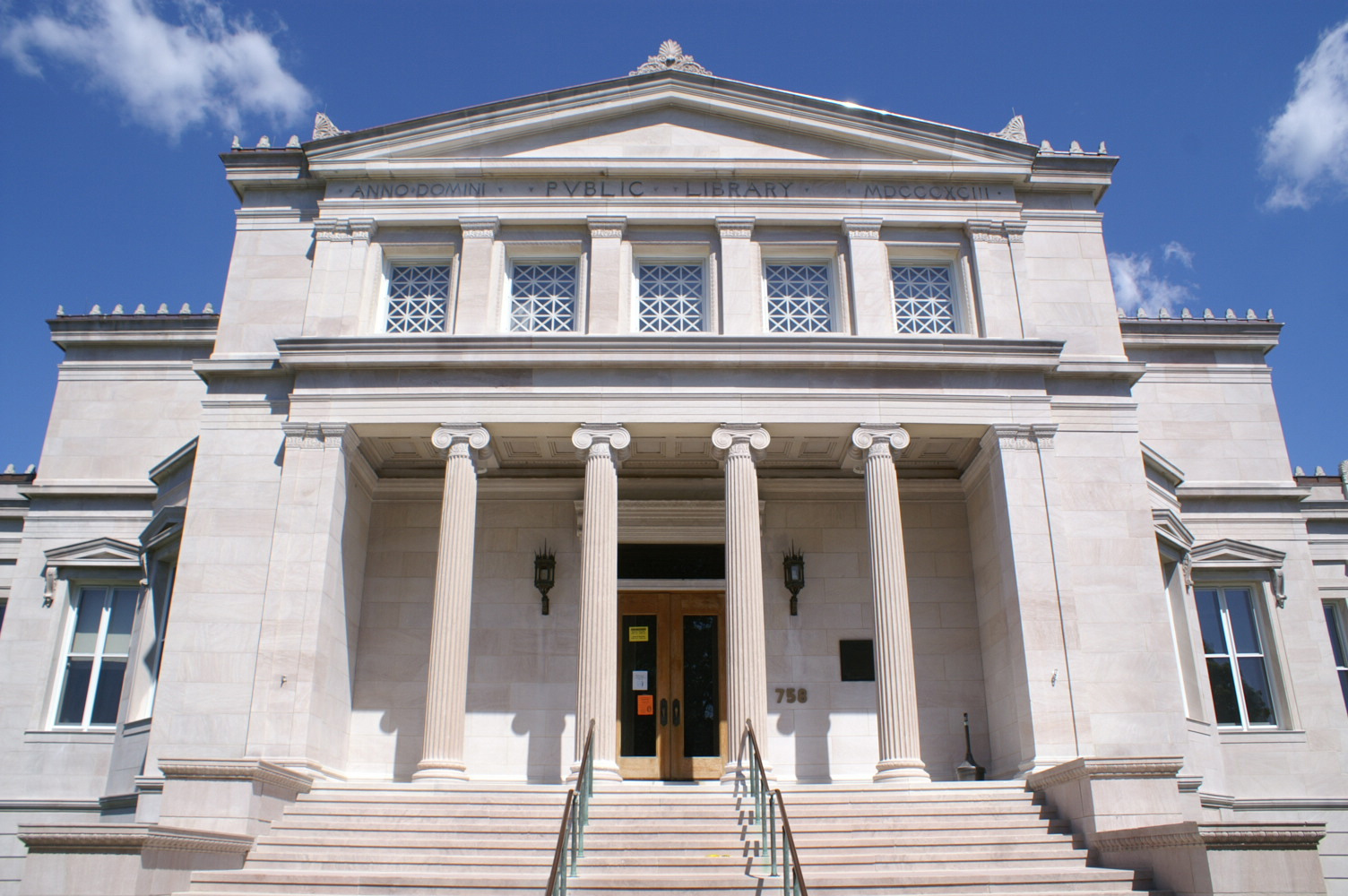
Are you in the mood for some measuring? We all know the Blackstone Library is a big building, but do you know just how big? Today’s 125th Anniversary Fact is about our front steps, which are positively massive at 39 feet wide! That means you could fit 3 African Elephants on our front steps (about 13 feet long each), or a whole school bus (36 feet wide) with room to spare! Our stairs are even bigger than the noses on Mount Rushmore: Washington’s nose is only 21 feet long for example. You’d only need 4 of our staircases (lengthwise) to equal Niagara Falls (height wise) at 167 feet! The next time you’re at Blackstone, be sure to take a moment to pay some extra attention to our lovely front stairs–they’re an excellent addition to our building!
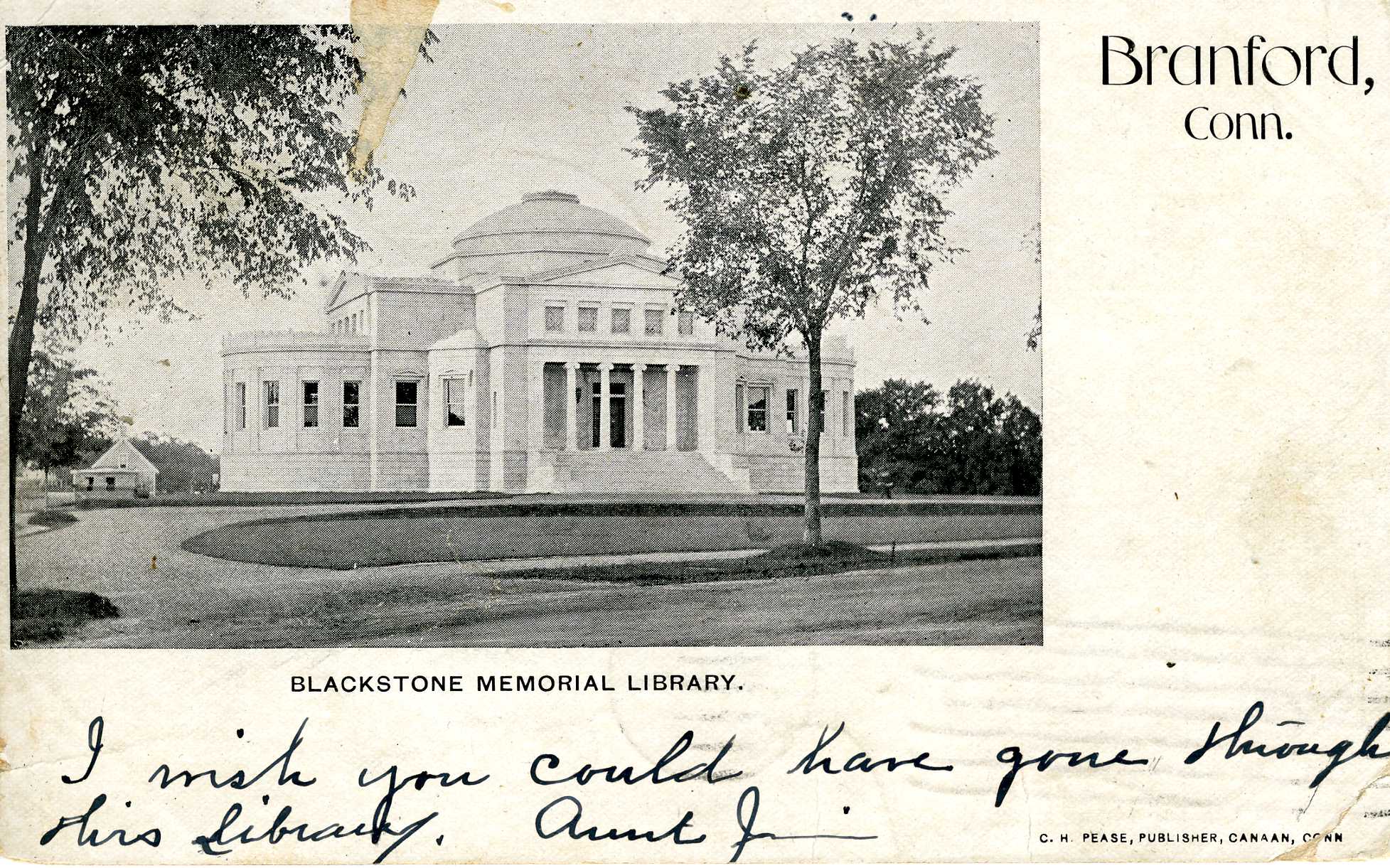
Greetings from Blackstone Library!
Did you know the Blackstone Library was once a popular topic for local postcards? Since it’s the end of vacation season here in New England and fall has officially arrived, we decided to feature one of our library postcards as today’s 125th Anniversary Fact. This one reads “I wish you could have gone through this library – Aunt J.” The Library has an extensive collection of these postcards spanning almost a century. While the scenery, landscaping, and vehicles may change, the Blackstone is here to stay!
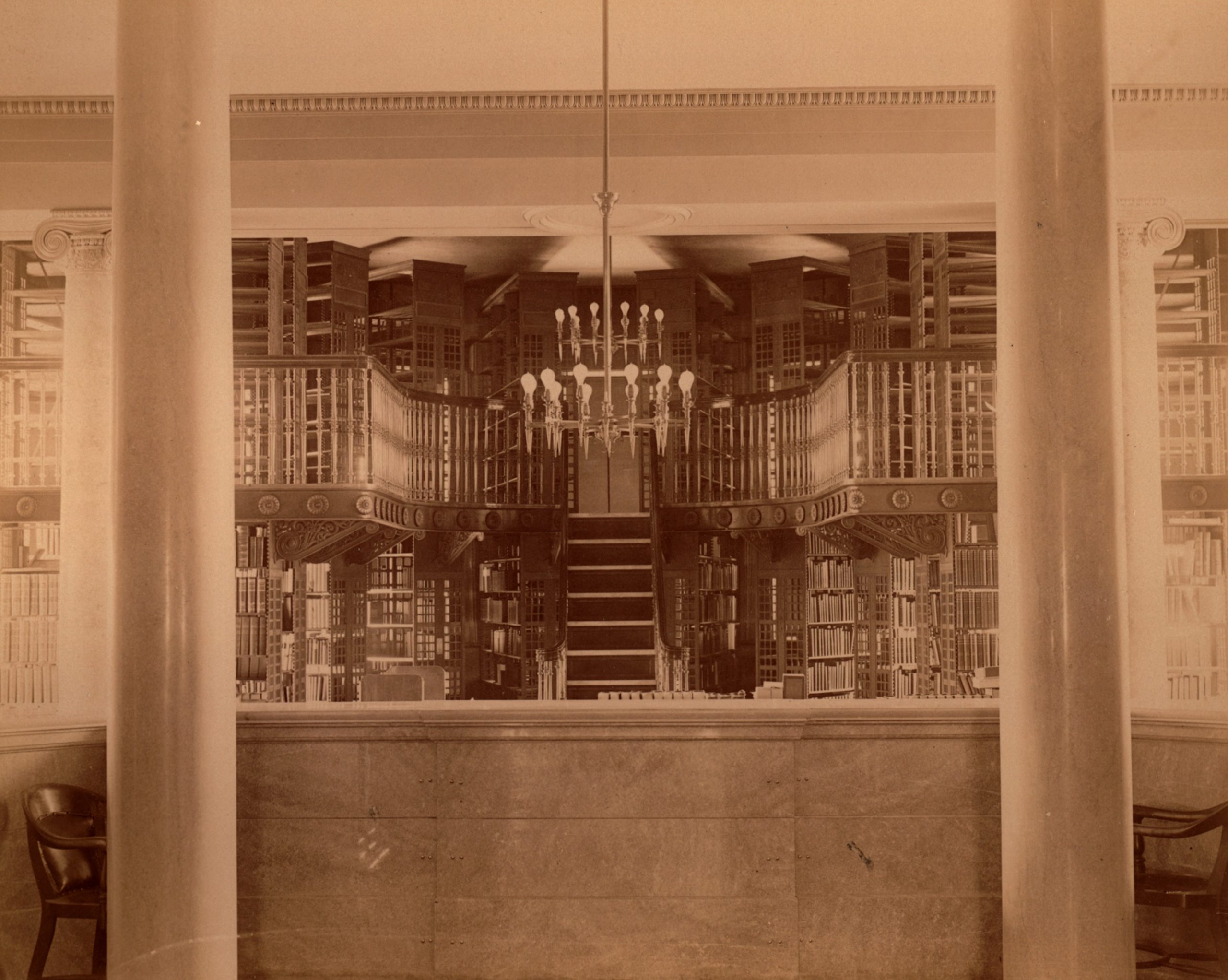
Today’s 125th Anniversary fact was inspired by a visit from a former Blackstone Library Director! She stopped in recently to see our newly renovated space, and remarked on the absence of the old marble desk. This got us curious, so we did a bit of digging into our photo archives and found this shot of the Mezzanine area dominated by a truly massive marble desk! Why the need for such an imposing piece of furniture? Our best guess is that it’s because the Blackstone used to be a closed stacks library. Closed stacks are generally only found in libraries with rare or valuable collections or in archives these days, but it used to be the norm at Blackstone. If you wanted a book, the only way to get it was to ask the librarian directly and they would get the book from the stacks for you–no browsing allowed! The huge wall to wall desk prevented patrons from accessing the books directly, and the only way to peruse the collection was through the card catalog. We much prefer our current open stacks model, but we also wouldn’t mind the return of such an impressive work space!
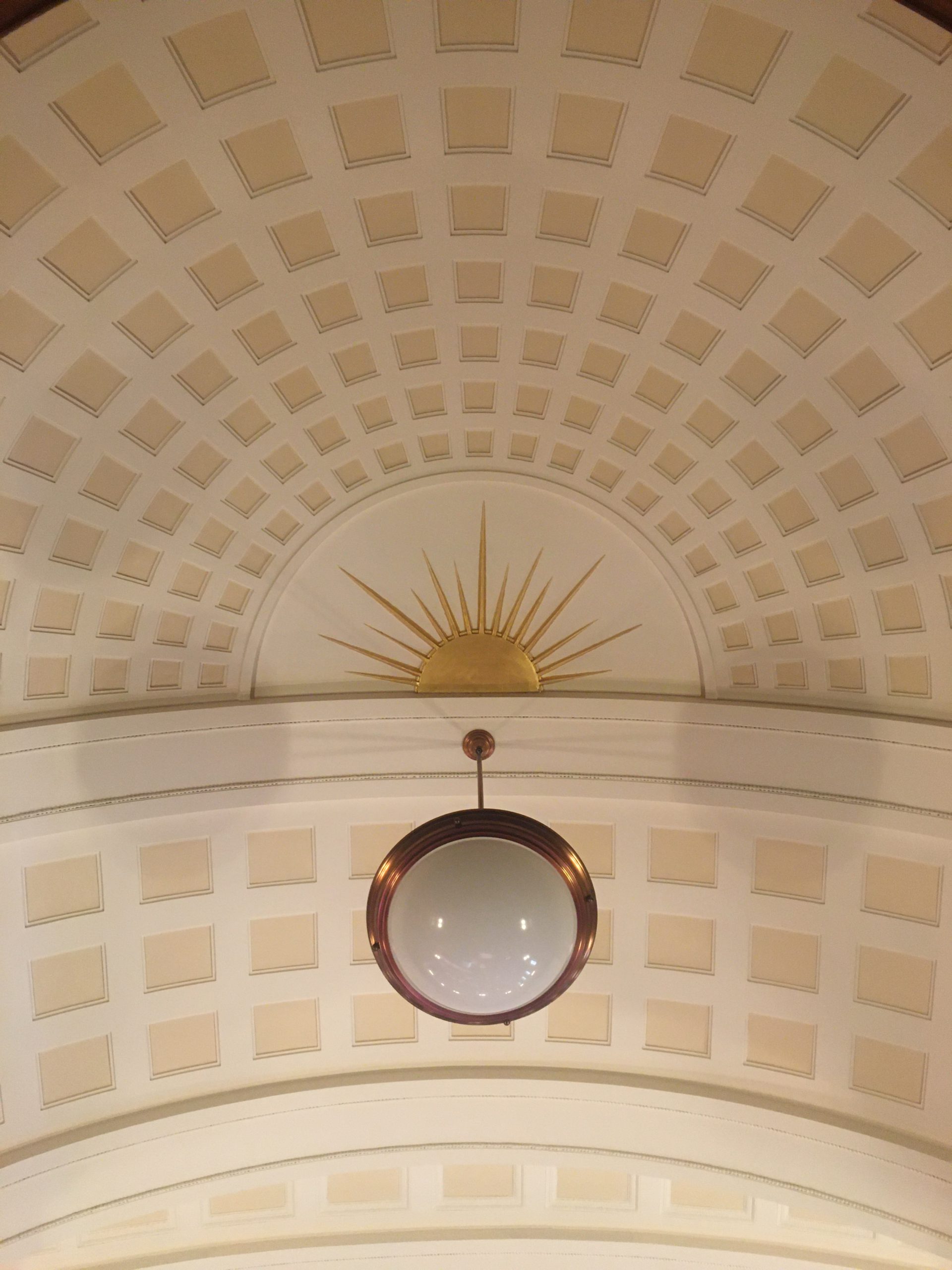
As we’re sure you all know, the delight is in the details at the Blackstone Library! For today’s 125th Anniversary fact, we’re sharing a detail so obscure that even most of the staff members were totally unaware it existed until the recent renovation brought it to light. It’s unlikely you’ve ever been on the stage of the auditorium, but if you ever were and happened to look up, you might have noticed a subtle sunburst detailed in the plaster ceiling highlighting the light fixture. When the ceiling was repainted during the final phases of the renovation, this little detail got a huge upgrade and is now a standout feature in gold. The next time you’re in the auditorium, be sure to look up–we’re sure you’ll have a new appreciation for all the craftsmanship that’s gone into the building past, present, and future!
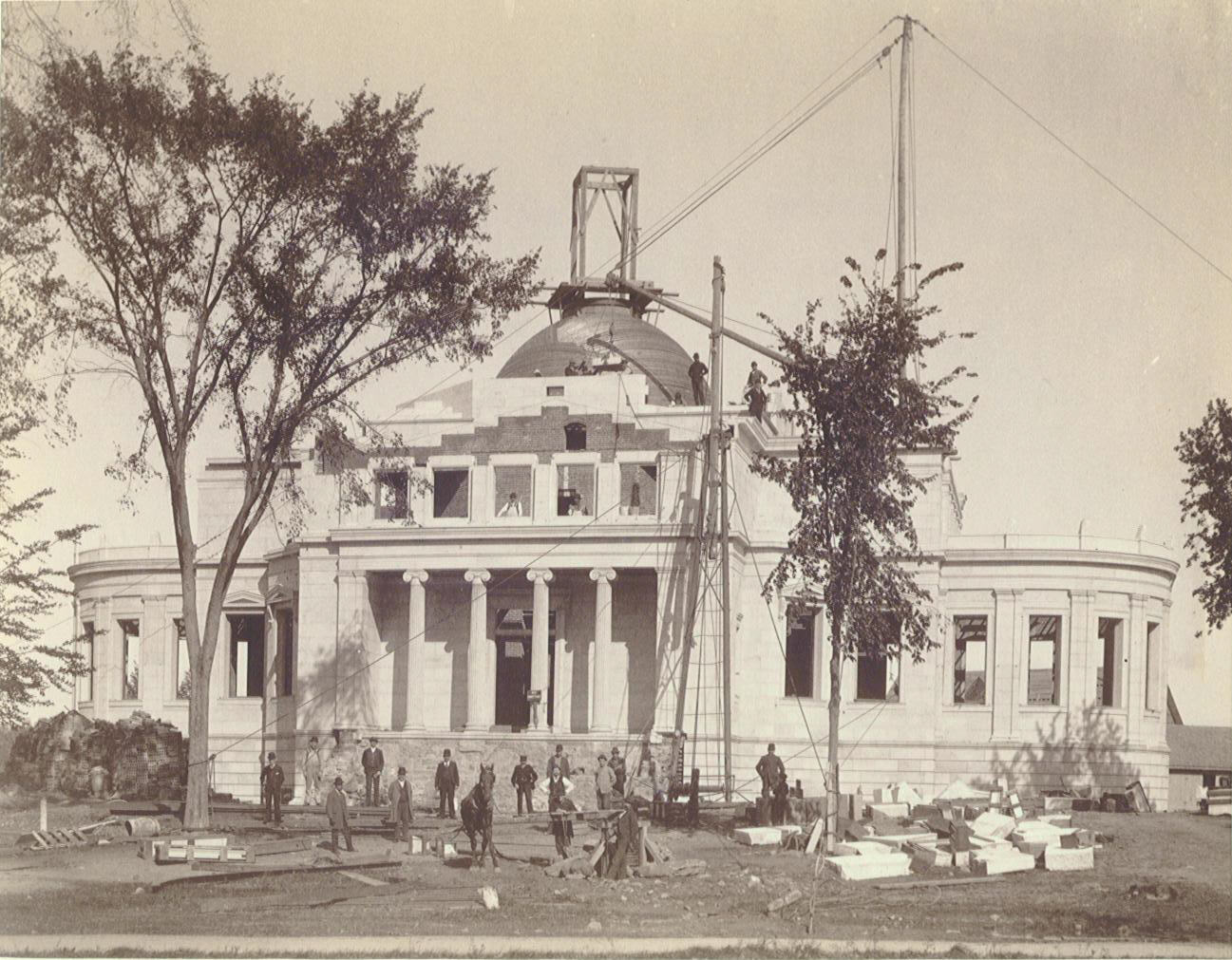
Today’s 125th anniversary fact is all about history in the making! 2021 marks the 125th year the Blackstone Library has been serving the Branford community and to mark that momentous occasion we have some brand-new commemorative library cards available. The two designs feature different historic aspects of the building so you can carry a little piece of history in your pocket! One design features the murals on the library dome, but since we’ll be featuring the dome in future posts, today we’re letting the other design shine through! This card features a photo of the library while it was still under construction, specifically in October of 1894. You can see that most of the exterior has been completed, but the interior still has a long way to go! These photos were taken at the request of Probst Construction Company, the firm that built the library. They were taken by the Stoddard Studio right in New Haven, and for many of them we know the name of the actual photographer–Harry O. Andrews. You can see this picture, and many other library construction photos, on our online archive available on our website!
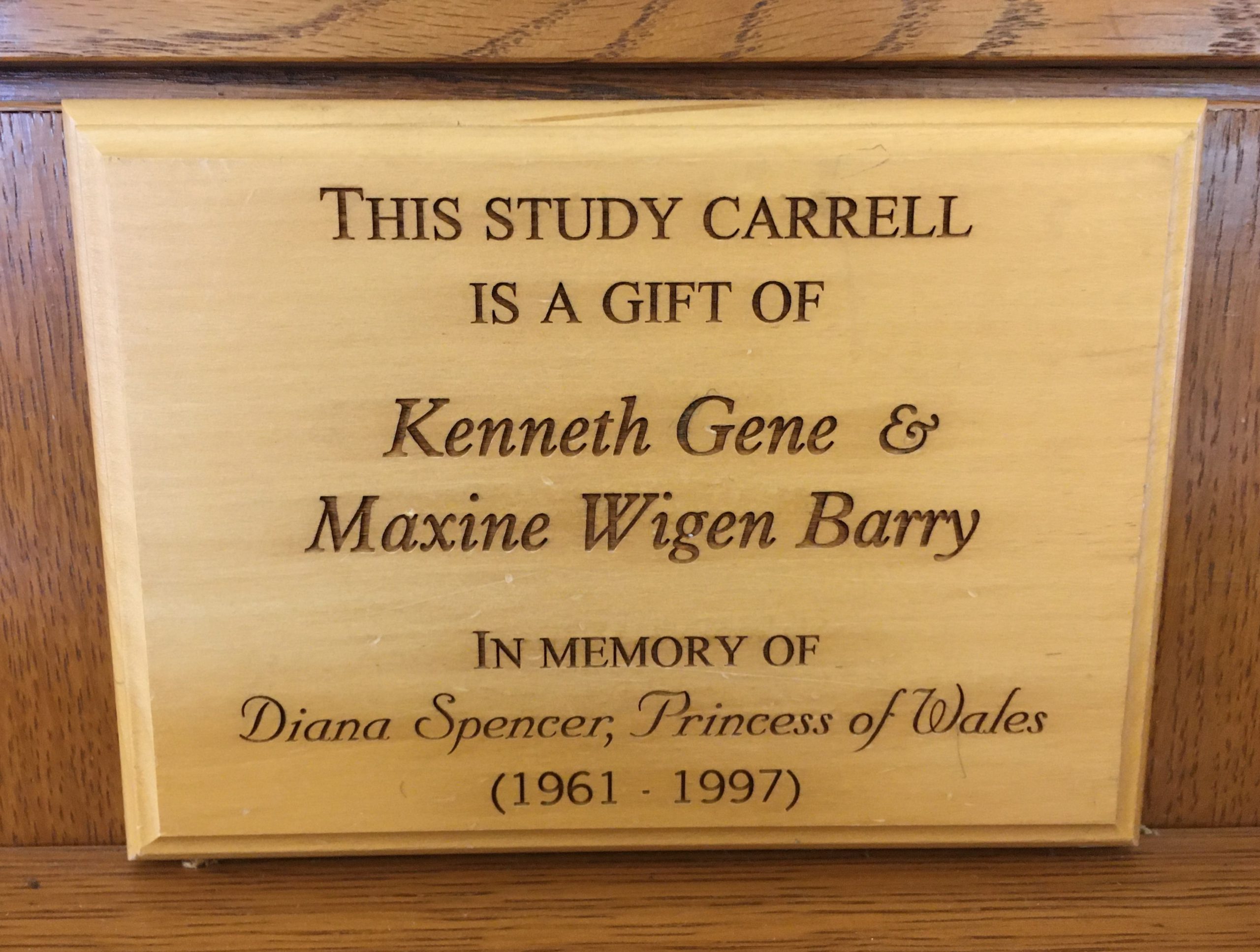
Tomorrow marks the 24th anniversary of the death of Diana, Princess of Wales. She was an incredible person who was loved by many, and who is remembered today just as much for her humanitarian efforts as for being a member of the British Royal Family. Her life was so impactful even in our little corner of the world that we have a study carrel on the Mezzanine donated by a local couple and named in her honor. Princess Diana’s name may be the most famous one featured on a plaque in the building, but there are dozens of them throughout the library and many more featured in books throughout the collection. Each one represents a member of our community, and we’re proud to help carry on the memory of each and every one of them.
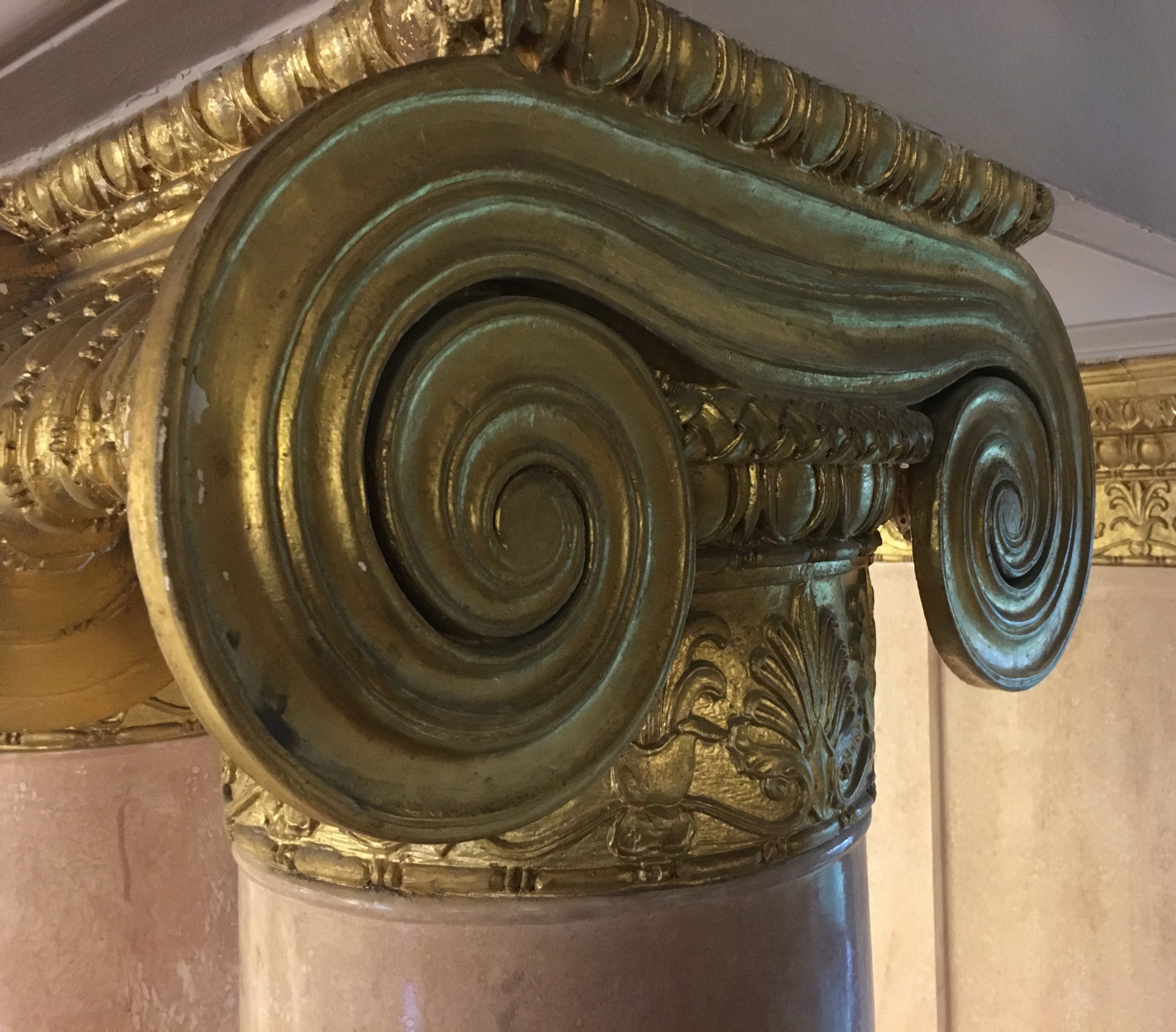
The nasty weather from the last few days has made us grateful for our very sturdy Blackstone Library! We thought you might be interested in learning a little bit abut the lovely marble columns that hold the building up no matter what the weather is doing. The Blackstone is full of columns, most notably in the Rotunda, Reading Room, and Mezzanine area. According to the architect Solon Spencer Beman, the swirl topped columns in the building were inspired by those at the Erechtheion–an ancient Greek temple on the Acropolis in Athens. But did you know some of these columns are hiding a well-kept secret? It’s easy to assume all the columns are made of marble, but those with gold painted tops are actually made of something called scagliola (don’t worry, we had to look it up too!). Scagliola is a type of fine plaster that is mixed with glue and dyes to imitate the appearance of marble and then polished to a shine. While it was popular in the 17th century as a marble alternative, the use of scagliola had begun to decline by the 19th century, making our columns a later example of the technique.
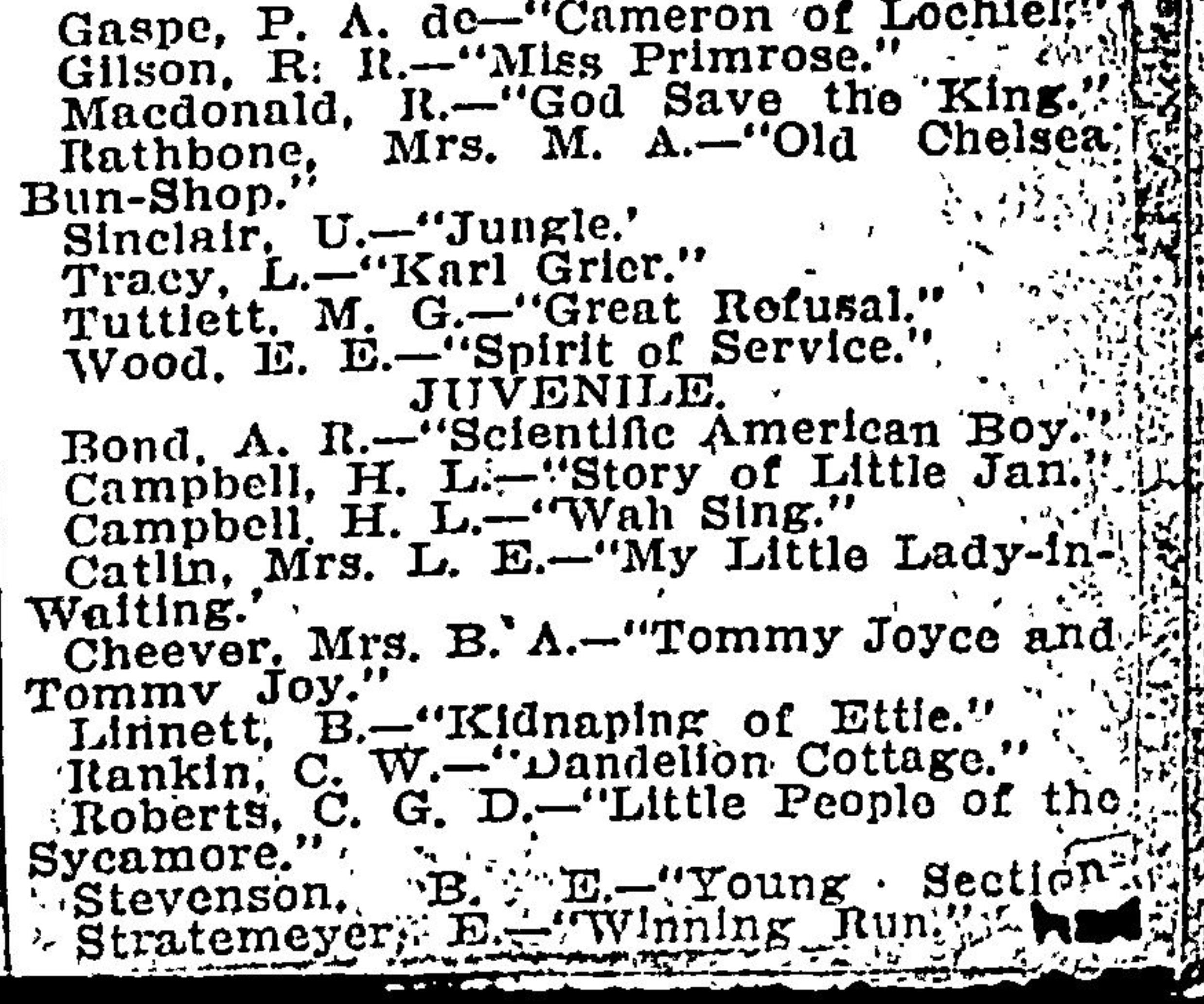
The Blackstone Library is home to lots and lots of books, and new ones arrive almost every day. More books are being published than ever before, but back when the pace of publishing was a little slower, the Blackstone used to publish a list of some of our newly acquired titles in the local newspaper. This list appeared in the New Haven Evening Register in about January of 1906. Can you spot the history making title? We’ll give you a hint–if you’ve ever read it, you probably avoided meat for at least a little while after finishing.
You can still find a list of the newest books we’ve added to our collection, now updated for the 21st century! Check it out as part of our online catalog here. Who knows, maybe you’ll be the first to get your hands on a history making title today!

We have a new face in the Reference Department and the fun and excitement of seeing the library through fresh eyes inspired this week’s 125th Anniversary Fact. We all know the library is an old building, but it’s easy to forget how old until you’re confronted with the day to day reality of it. For example, a handful of doors in the building are still opened with their original skeleton keys circa 1896. If it ain’t broke, don’t fix it as they say! We also have several decommissioned ones floating around too, like the one featured in today’s fact. We’re not always sure which doors they used to open (or if the door is even still in the building), but we like to keep them around anyway. As you can see this key was manufactured right here in Branford, probably at Branford Lock Works.
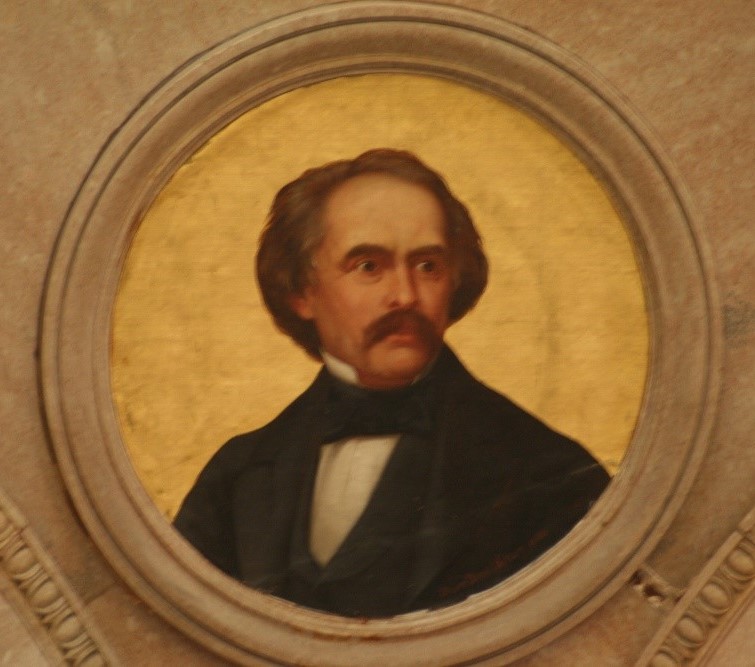
For today’s 125th anniversary fact we’re sharing some information about another famous author featured as part of our rotunda! Nathaniel Hawthorne is perhaps one of the most famous authors from New England, and arguably one of the most important American writers of all time.
Born in Salem MA in 1804 and descended from a prominent Puritan family, Hawthorne was the son of a sea captain who died when Nathaniel was 4 years old. In order to earn a livelihood Hawthorne served as surveyor of the port at Salem (1846-49), where he began writing his masterpiece, The Scarlet Letter (1850). Set in 17th-century Puritan New England, the novel delves deeply into the human heart, presenting the problems of moral evil and guilt through allegory and symbolism. It is often considered the first American psychological novel.
For a time the Hawthornes lived at “Tanglewood,” near Lenox, Mass. where Hawthorne befriended his neighbor Herman Melville. Melville was one of the first to appreciate Hawthorne’s genius and the two were reportedly very close friends. Aside from his importance as a novelist, Hawthorne is justly celebrated as a short-story writer. He helped to establish the American short story as a significant art form with his haunting tales of human loneliness, frustration, hypocrisy, eccentricity, and frailty. Among his most brilliant stories are “The Minister’s Black Veil,” “Roger Malvin’s Burial,” “Young Goodman Brown,” “Rappaccini’s Daughter,” “The Great Stone Face,” and “Ethan Brand.”
Be sure to come and visit our portrait of Nathaniel Hawthorne (and all our other amazing portraits and paintings) on your next visit to the Blackstone!
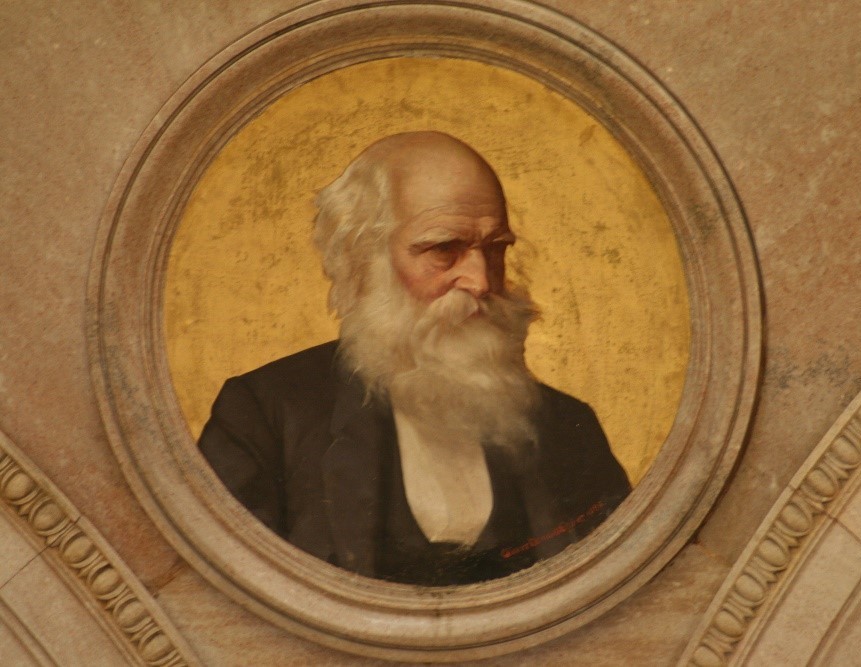
For today’s 125th Anniversary Fact we’re sharing a little bit about one of the authors featured in the library’s rotunda. Each portrait below the dome features a famous author from New England, and today we’re featuring William Cullen Bryant. Born in Massachusetts in 1794, Bryant was trained as a lawyer but eventually made his living as both a successful poet and the editor in chief of the New York Evening Post. You can read more about him on our Facebook page!
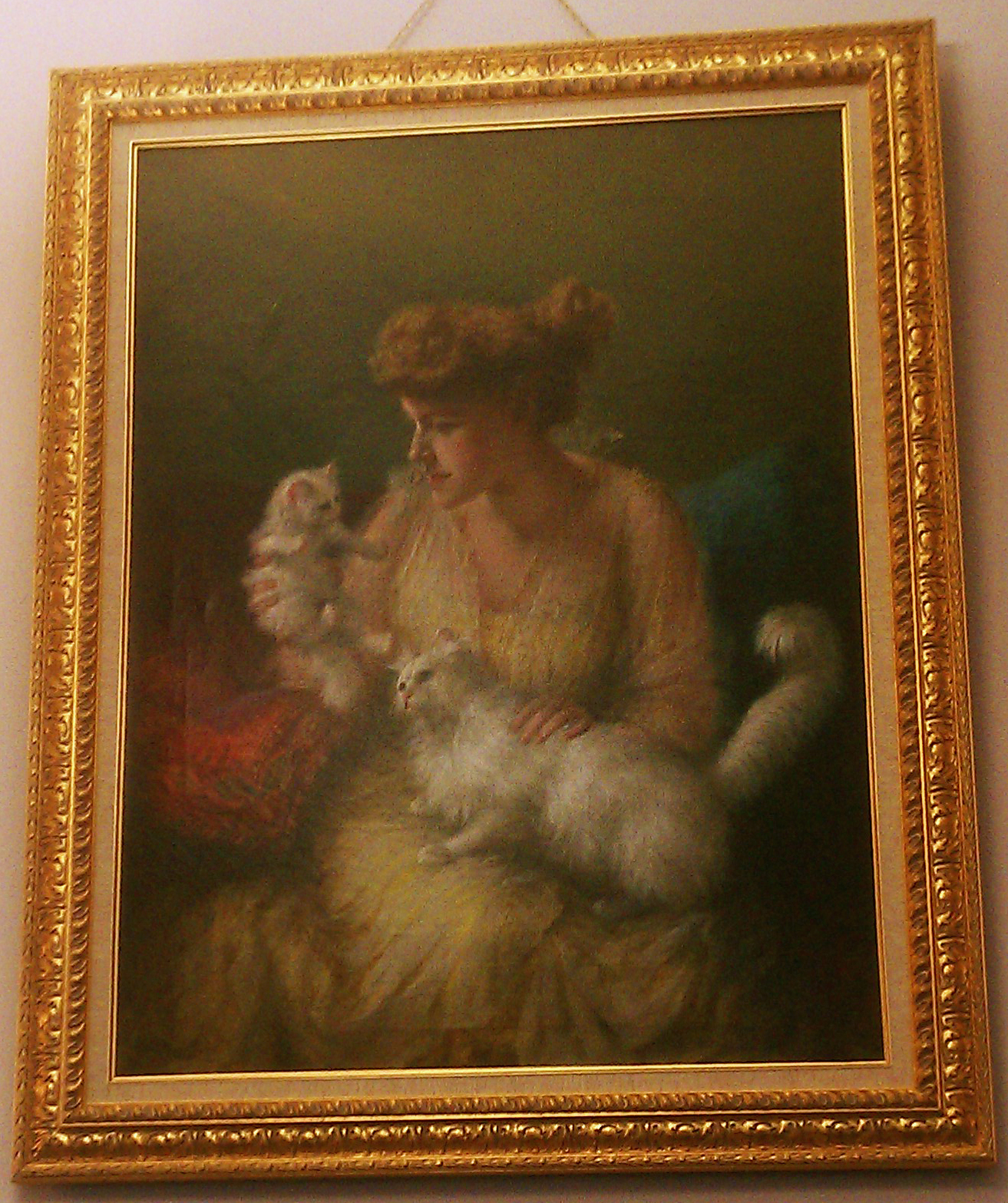
Laugh and the World Laughs with You
Weep and You Weep Alone
Did you know these famous lines were composed by Branford’s own Ella Wheeler Wilcox? Her portrait hangs in the Blackstone Library Reading Room, so we’re making her the topic of today’s 125th Anniversary Fact! Ella was born in Wisconsin in 1850 and began writing poetry at the age of 5. She settled with her husband, Robert Marius Wilcox, in the Short Beach section of Branford in 1891. She published numerous volumes of poetry throughout her life, the most famous of which was Poems of Passion published in 1883. During her time in Short Beach, she organized a village improvement society called White Wings with the aim of beautifying Short Beach and making it a center of intellectual life. Robert died suddenly in 1916 and Ella never recovered from the loss. While visiting injured WWI troops in France, she fell ill and passed away in Short Beach on October 30, 1919.
This portrait was painted in 1899 by Lilly Martin Spencer of NY, one of the most popular genre artists of the mid-nineteenth century. Both she and Ella were strong female figures in male dominated fields, and we like to think they had much to discuss with one another!
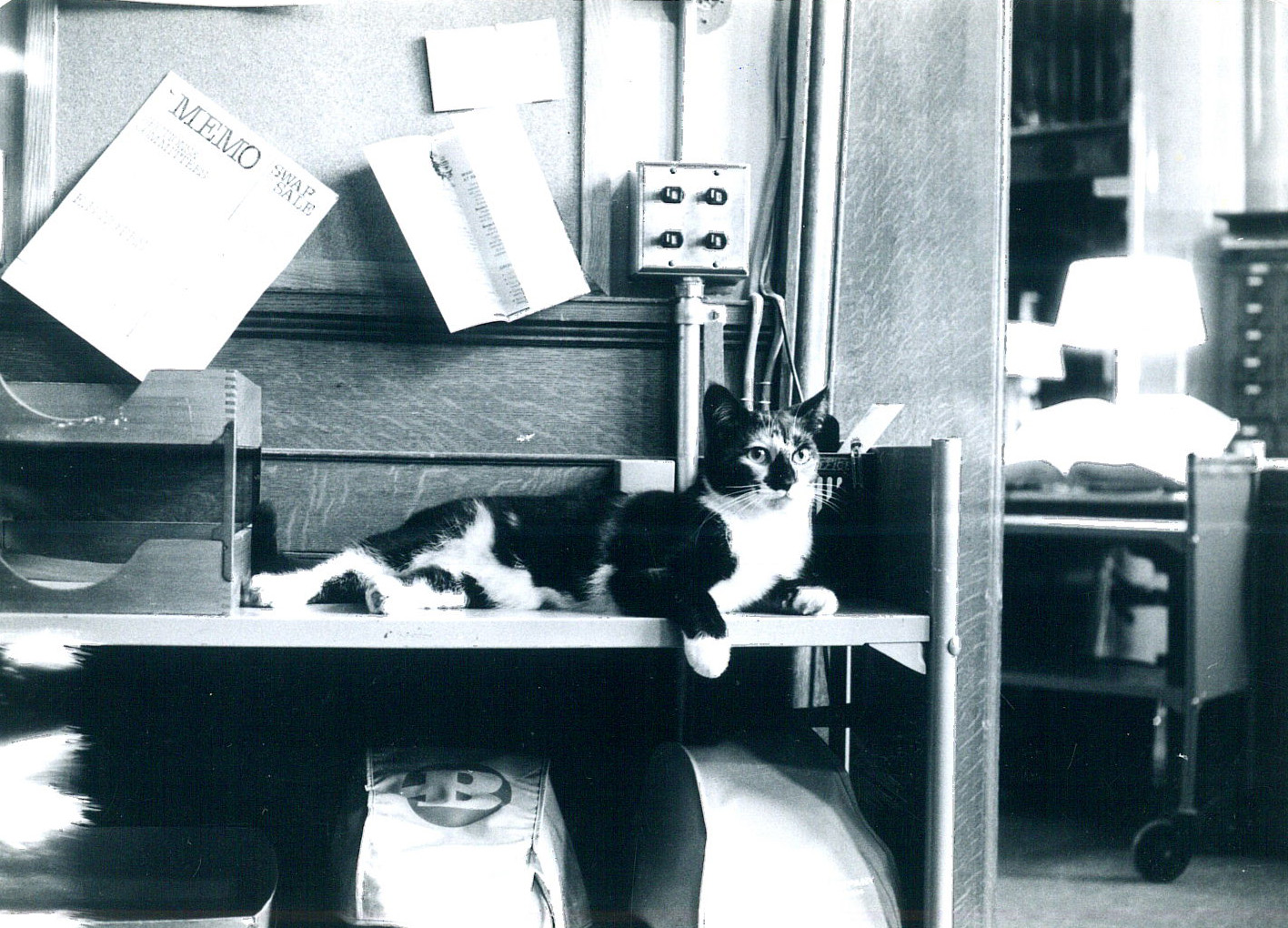
This year’s Summer Reading theme is Tails and Tales, so for this week’s 125th Anniversary Fact we’re sharing the tale of one of our favorite library tails! In 1978 the Blackstone Library made a new furry addition to the staff. In April of that year a stray calico cat took a liking to the library and, after spending one night, decided to make it her permanent residence. The staff enjoyed the company of the reportedly shy and occasionally sassy feline, and soon dubbed her Prudence the Library Cat. She had her own room on the top floor of the building, and enjoyed lounging at the check out desk and looking out her favorite window in the Director’s Office. She had free rein of the building and while she enjoyed being in the middle of things, she didn’t like to be the center of attention. Prudence certainly lived a life many people might envy–we’re certainly jealous!
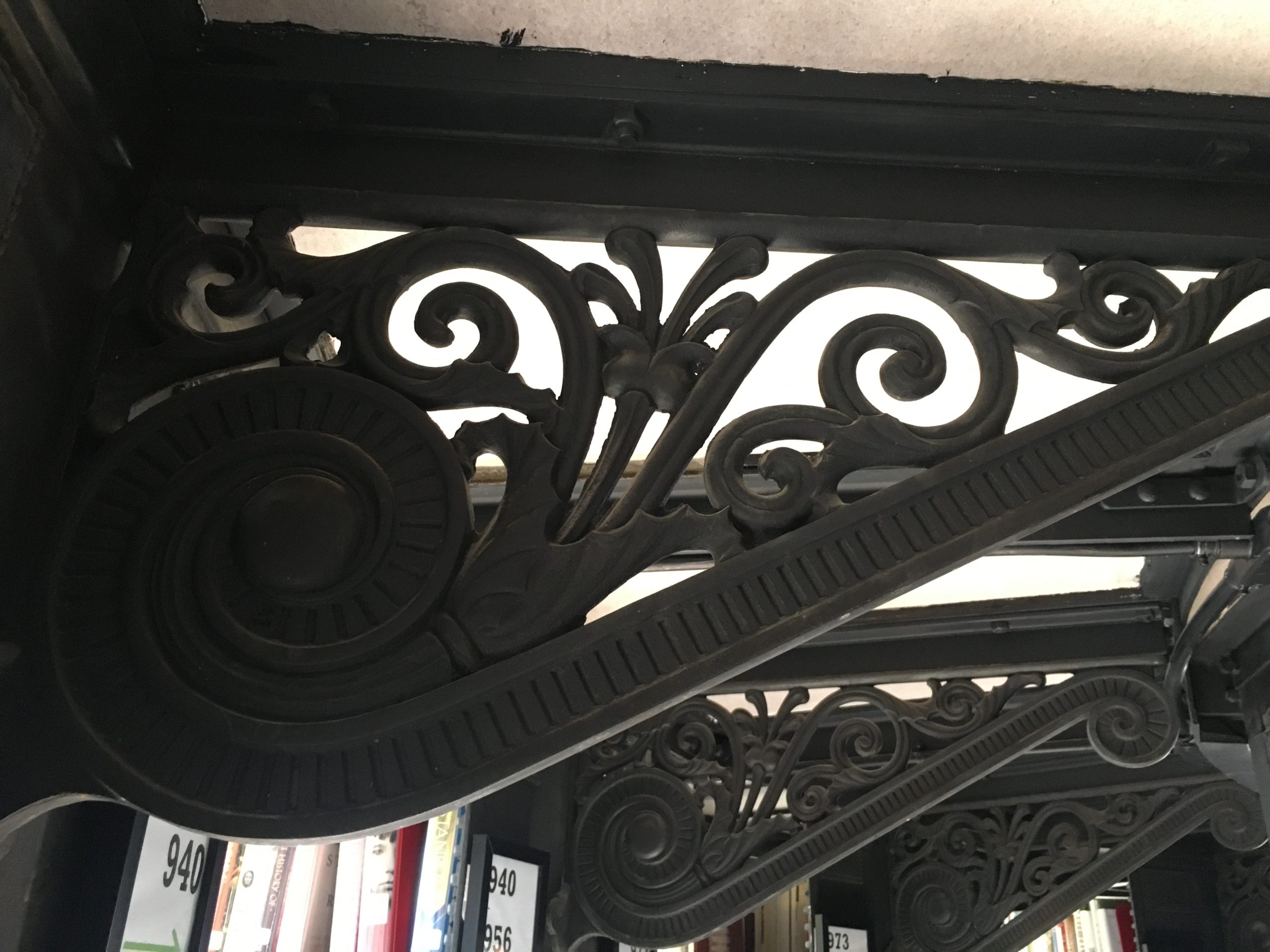
Today we’re showcasing the last remaining portion of original shelving in the Blackstone Library and it’s another reminder that they don’t make things like they used to! The shelving was made by the Snead & Co. Iron Works which had an office in Chicago. Because Timothy Blackstone was based out of Chicago, we find that many of the materials used in the building are sourced from there rather than New England. While the shelving is certainly functional, it also doesn’t shy away from being beautiful too. It features many intricate details that you simply don’t find in library furniture today, and we’re so grateful that it’s still serving it’s purposed 125 years later! If you want to see these shelves for yourself, you can find them on the middle floor underneath the mezzanine. They’ve been the home of many collections in the past, and they now house nonfiction and biographies.
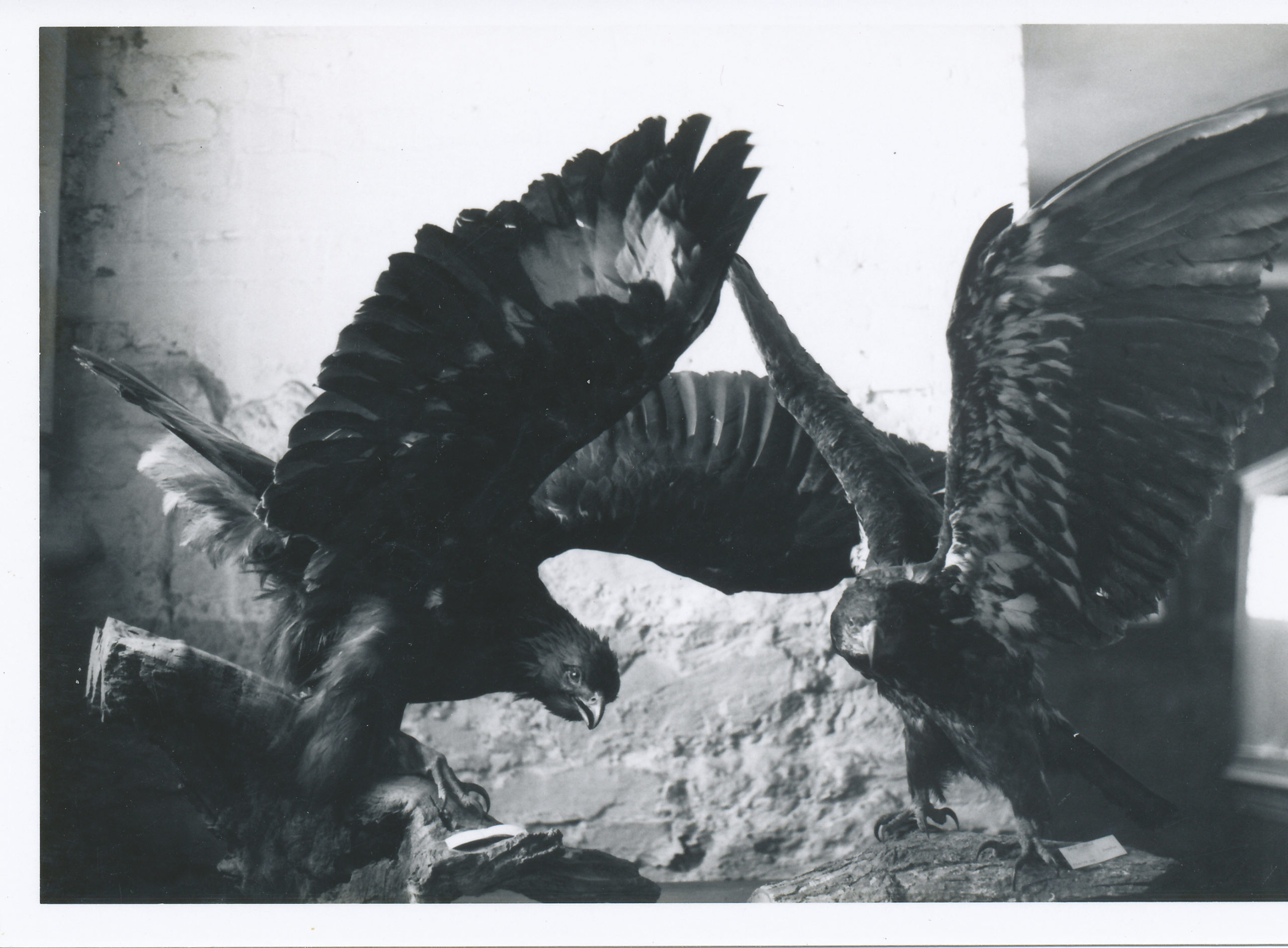
For today’s 125th Anniversary Fact we’re featuring a unique library collection we’re sure many of you remember fondly. The rooms on the upper floor once held displays of historical items and bird specimens until 1996, when the area was repurposed for the children’s space. We get lots of questions about the bird collection and it’s no wonder! The collection was extremely impressive and represented many different types of local species. According to our archives, the core of the collection was provided by Valdimar Hammer and the taxidermist was a Mr. Armstrong of Pawson Park here in Branford. We were certainly sad to see them go, but we know they found a great home at Earthplace Nature Discovery Center in Westport CT, a non-profit organization committed to building passion and respect for the natural world and a more sustainable future. There, the collection continues to educate and inspire a new generation of animal enthusiasts!
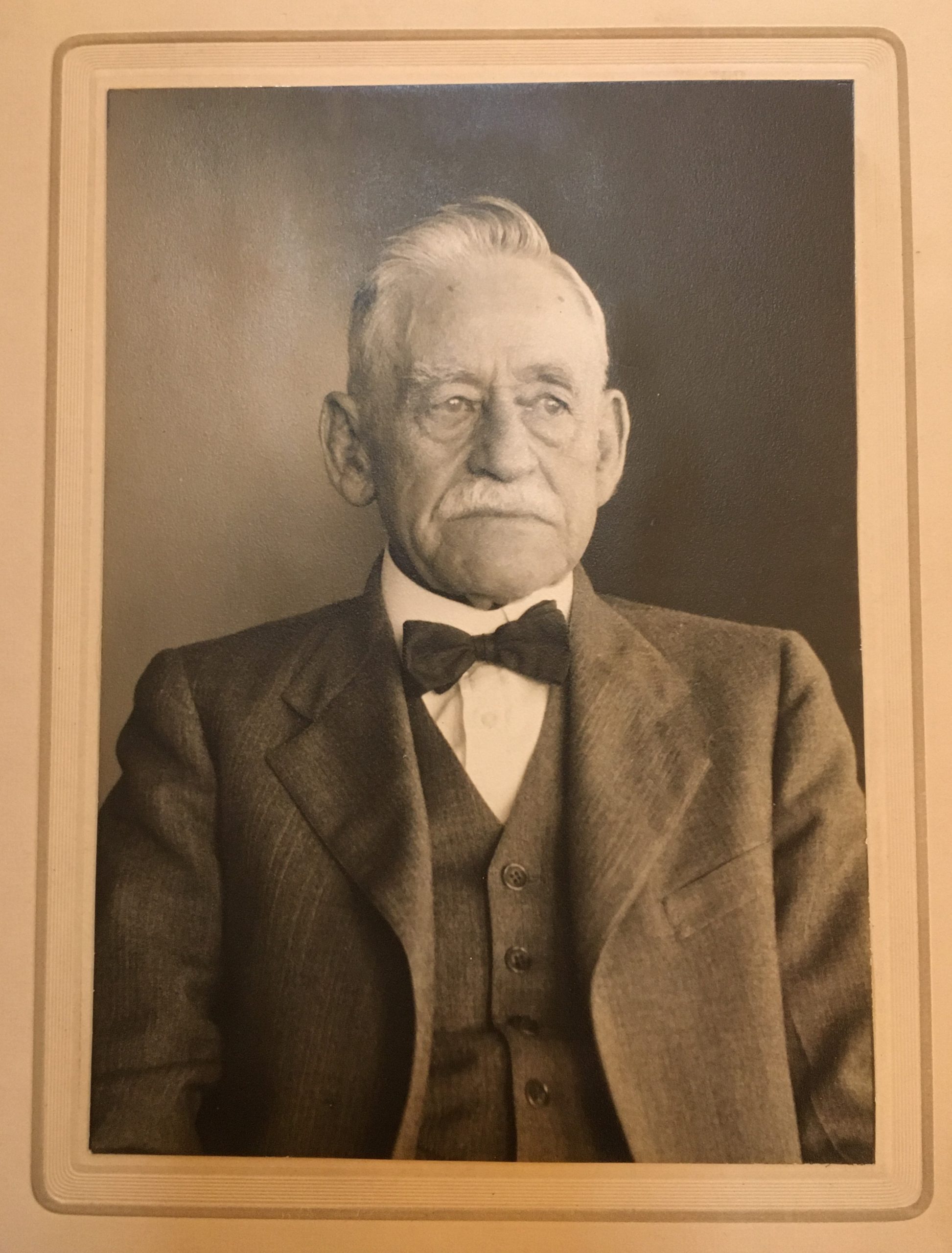
Taking care of the Blackstone Library is no easy feat! The building takes a lot of work to maintain, and we’d be lost without the hard work of our dedicated custodians throughout the years. Today’s 125th anniversary fact is about one of our earliest library custodians. Fred Minott Augur was the library custodian from 1905-1927 and we’re lucky enough to have a formal portrait of him in the library archives. His work was just as essential then as it is today–a newspaper article from 1916 makes sure to note that while he and his wife would be taking a vacation, his son Minott Augur “will have charge of his father’s work at the library.”
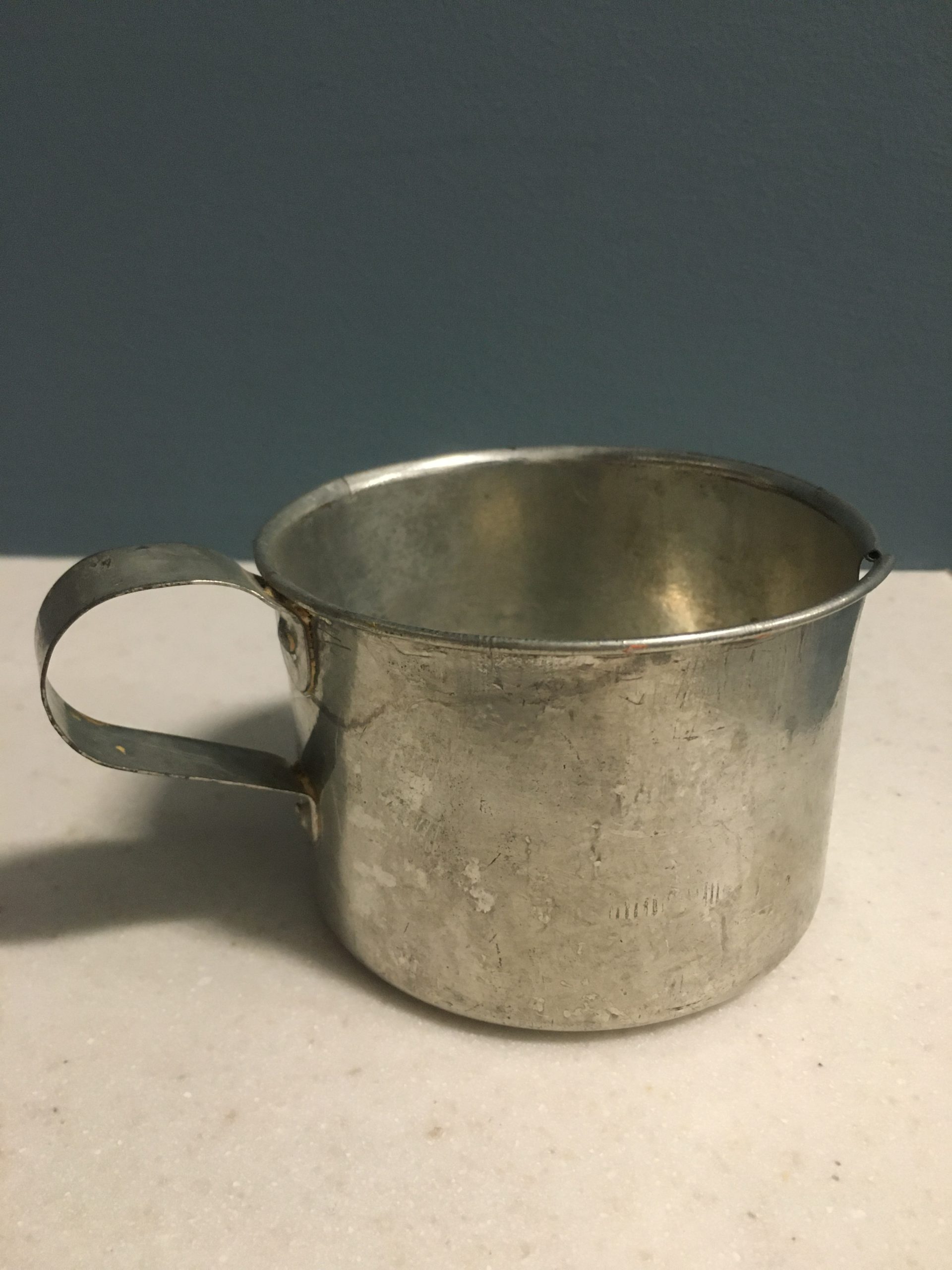
This week’s 125th Anniversary Fact is about an artifact found during one of our previous renovations. This cup was uncovered behind the rotunda along with a page from an 1895 newspaper. Originally used as a drinking cup, it was coated with zinc and finally used as a container for mixing paint. We wonder if that break in the lip just visible on the right was what demoted it from drinking cup to paint mixer! It has been carefully restored by Nancy and Bill Hendricks who have identified the design as one available between 1890 – 1900. You can visit it, and many other interesting Blackstone artifacts, in the display case on the top floor outside the computer lab!
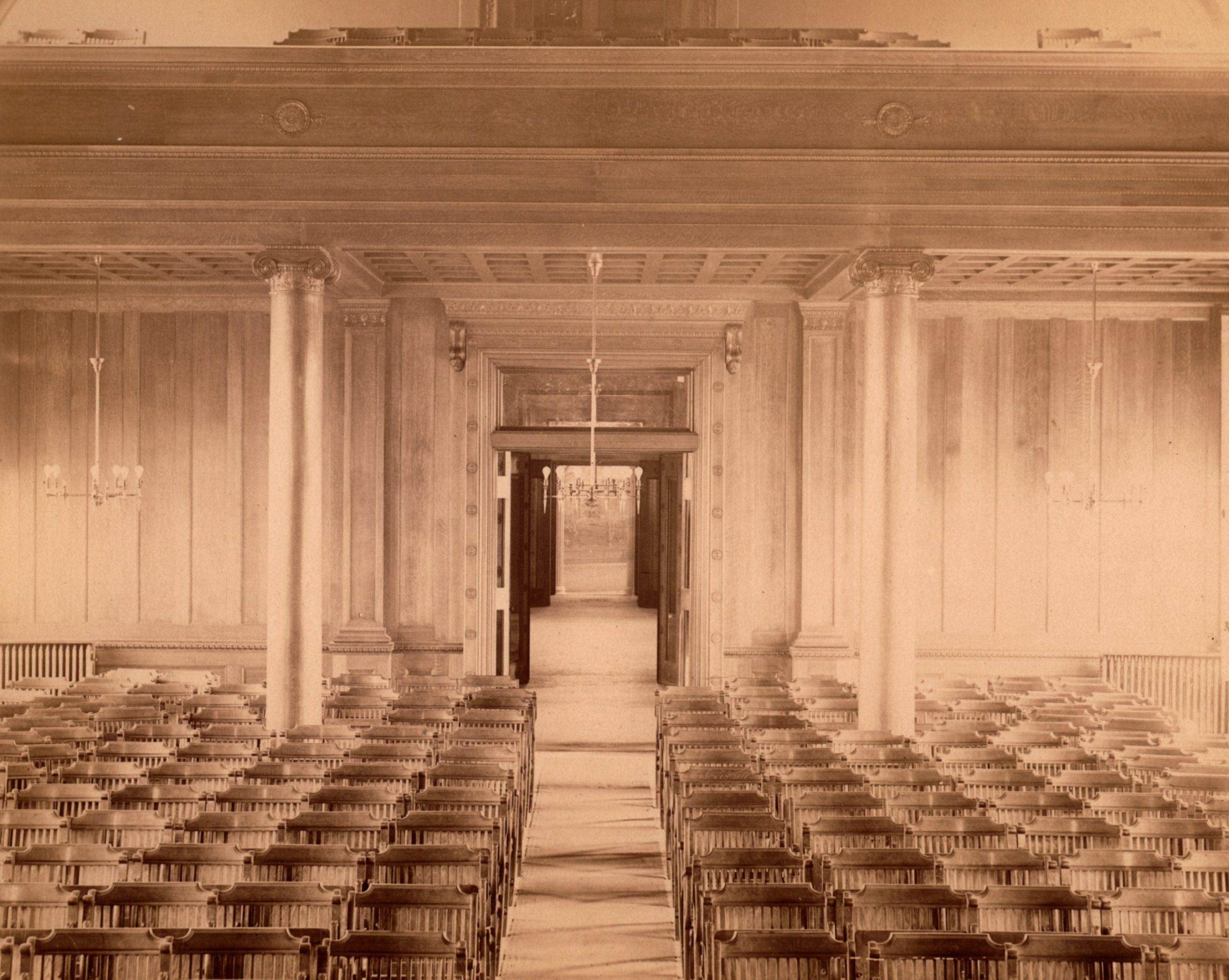
While we know it’s been a while since we’ve been able to host lectures, concerts, and other events in person, we’re sure you all remember one of our favorite library spaces–the auditorium! Here you can see the view from the auditorium stage just before the library was opened to the public. Today’s 125th Anniversary fact concerns the chairs you can see in the picture. We were sure that seating was all long gone, but back in 2019 William and Cynthia Kobak very kindly donated an original pair back to us. We always love it when pieces of Blackstone history find their way back home!
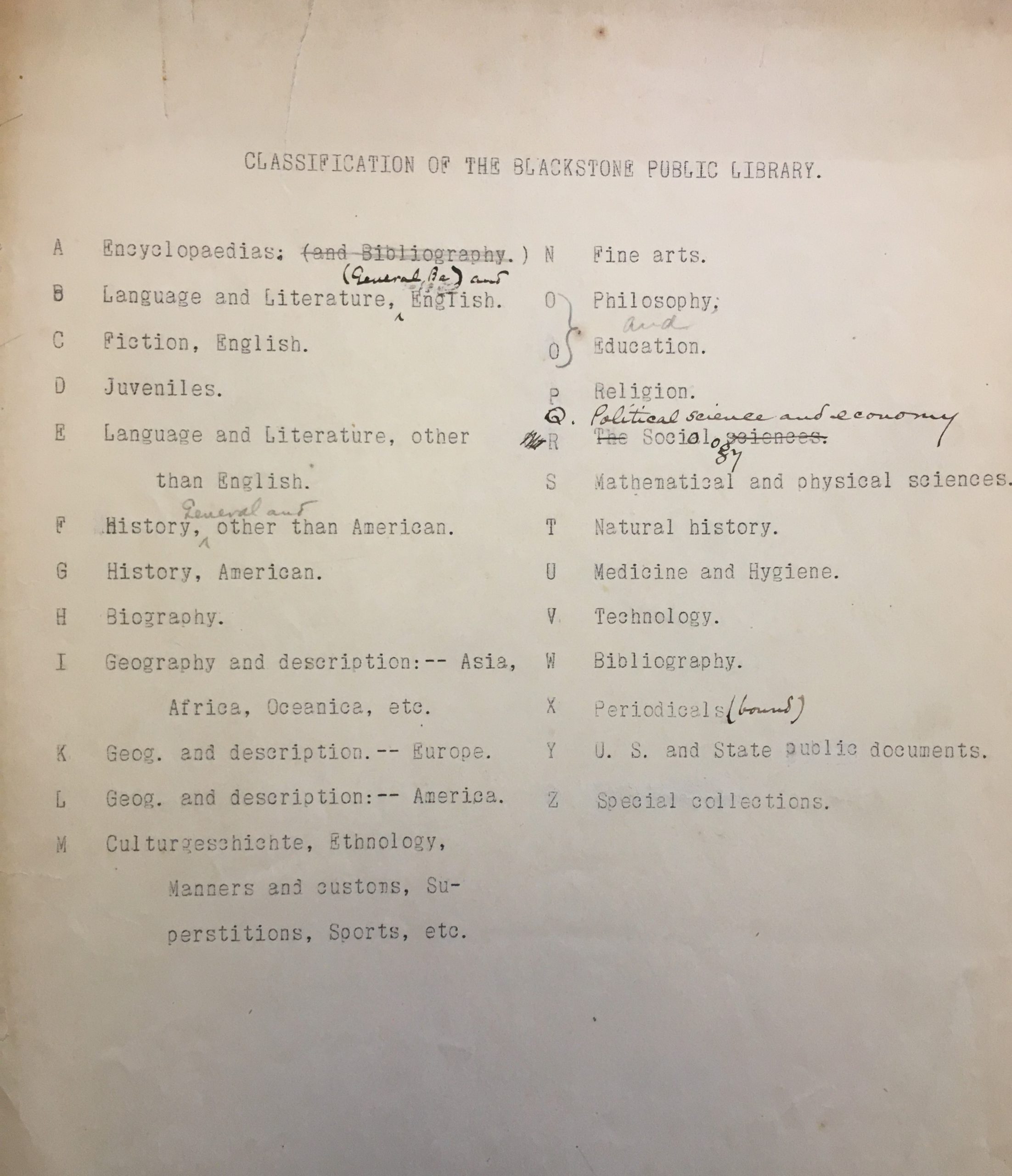
The Blackstone Library has always cultivated a spirit of creativity and innovation in its staff. This dates all the way back to the earliest days of the library, as evidenced by this week’s 125th Anniversary Fact. In our archives we have a document labeled Classification of the Blackstone Library. Why is this a big deal? Because it doesn’t match any known library classification system out there! It has elements of the Dewey Decimal System, the Library of Congress classification system (the gold standard for college and university libraries), and is reminiscent of some classification systems used in the UK. The Dewey Decimal system may be synonymous with the library these days, but that wasn’t always the case. It appears some of our early librarians felt his methods could be improved upon! We’re not sure if this system was ever put into place here at the Blackstone–the margin notes indicate that this was work in progress–but it’s an excellent reminder that the library is a living thing. We’re always adapting to best fit the needs of our community, and what works today may not work tomorrow–whether it’s a program, service, or classification system!
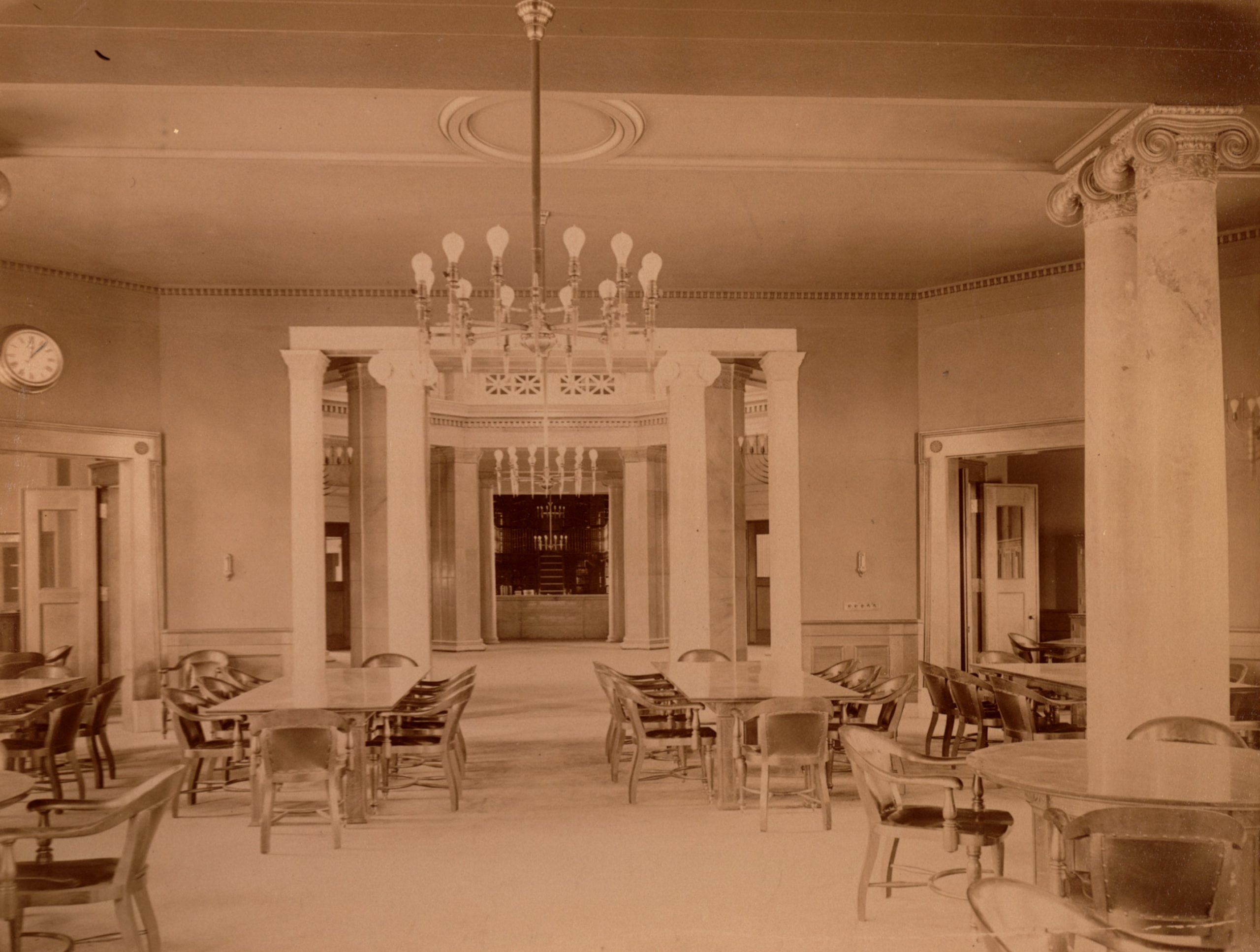
The Reading Room is one of the most popular destinations at the Blackstone, but it didn’t always look the way it does now. This photograph of the Reading Room was taken after construction of the library was finished, but before it was officially opened to the public. Most of this furniture is sadly long gone, but you may be able to spot a piece or two that is still in use today!
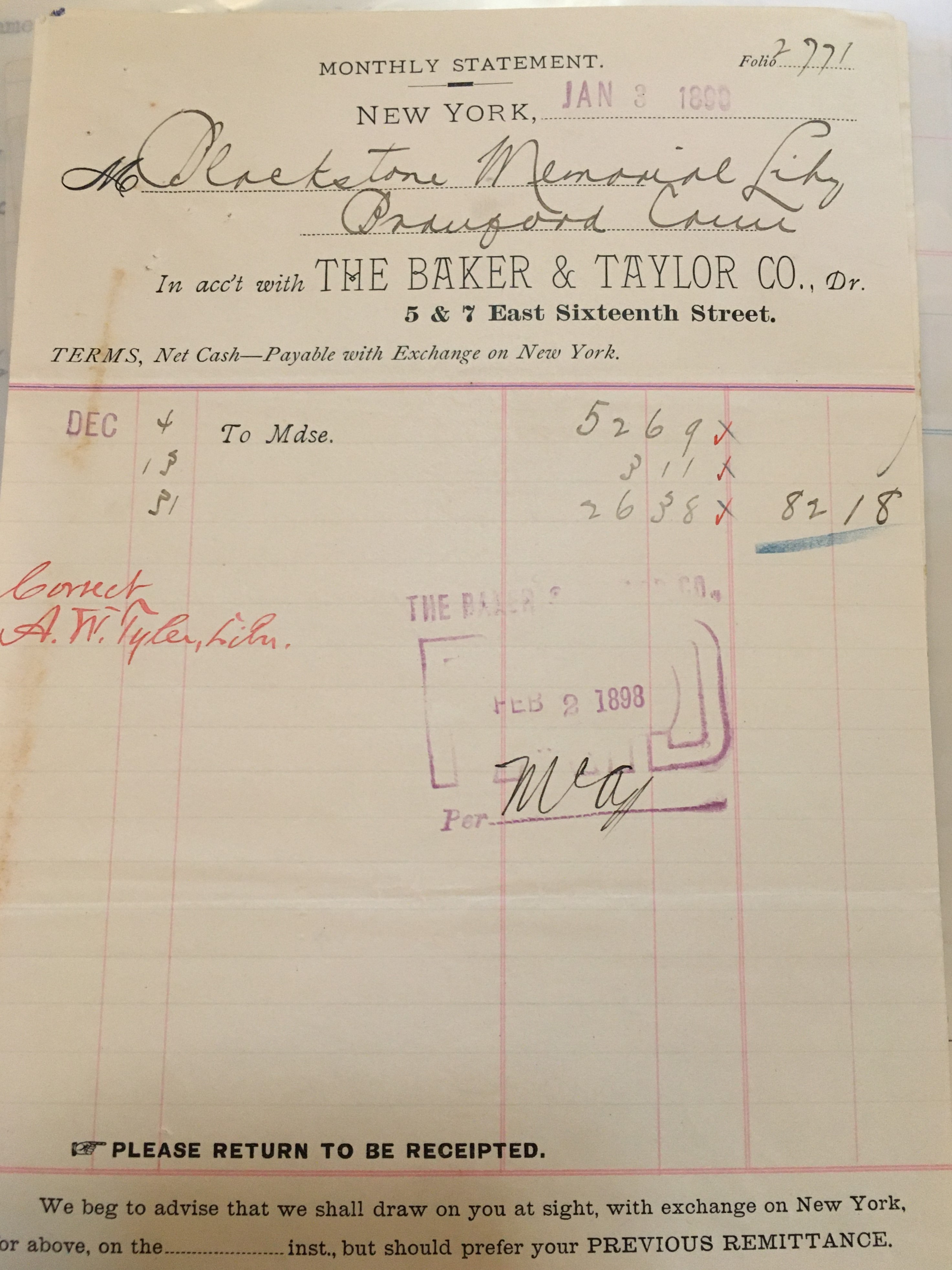
Today’s 125th Anniversary Fact is almost 125 years in the making and comes from our financial archives. While investigating last week’s fact about our fancy flooring, we came across this receipt from the book supplier Baker and Taylor dated 1898. What’s so interesting about that? Well we still get most of our books from them today! Here at the Blackstone Library, we’re certainly consistent. We order the books online these days rather than by correspondence, but maybe we should ask for a long-time customer discount?
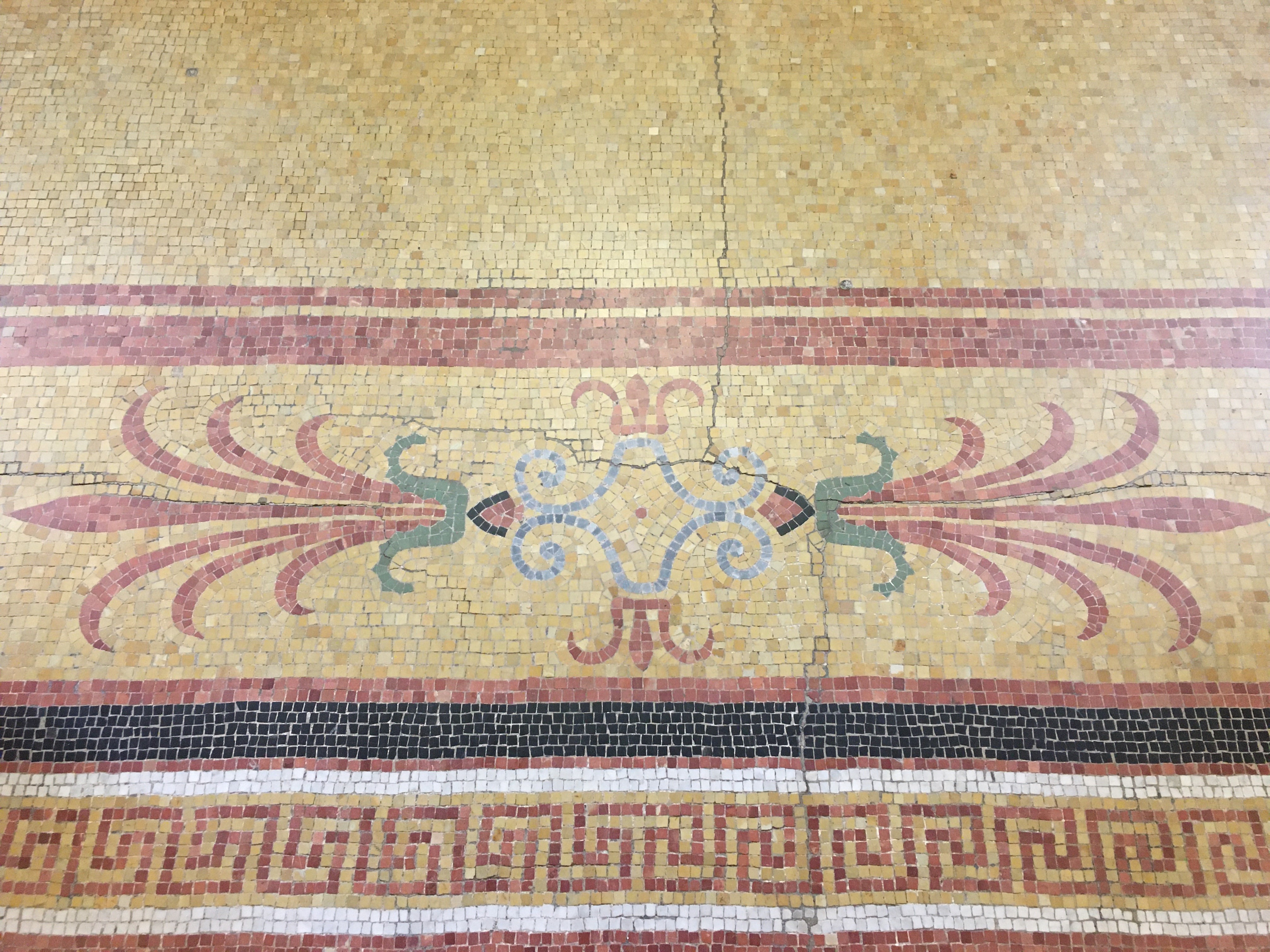
For today’s 125th Anniversary Fact we’re exploring a library detail that’s right under your nose…and your toes! It’s probably been a while since you’ve seen it in person, but our rotunda is home to 12,500 square feet of hand laid mosaic tile flooring imported from Paris. Each tile is only about the size of a nickel which makes the variety of designs featured even more impressive! Whoever laid the tile was truly a master craftsman, and we’re currently trying to learn more about the origins of the materials used and who exactly may have done the work. Stay tuned–we hope to have an update for you some day soon!
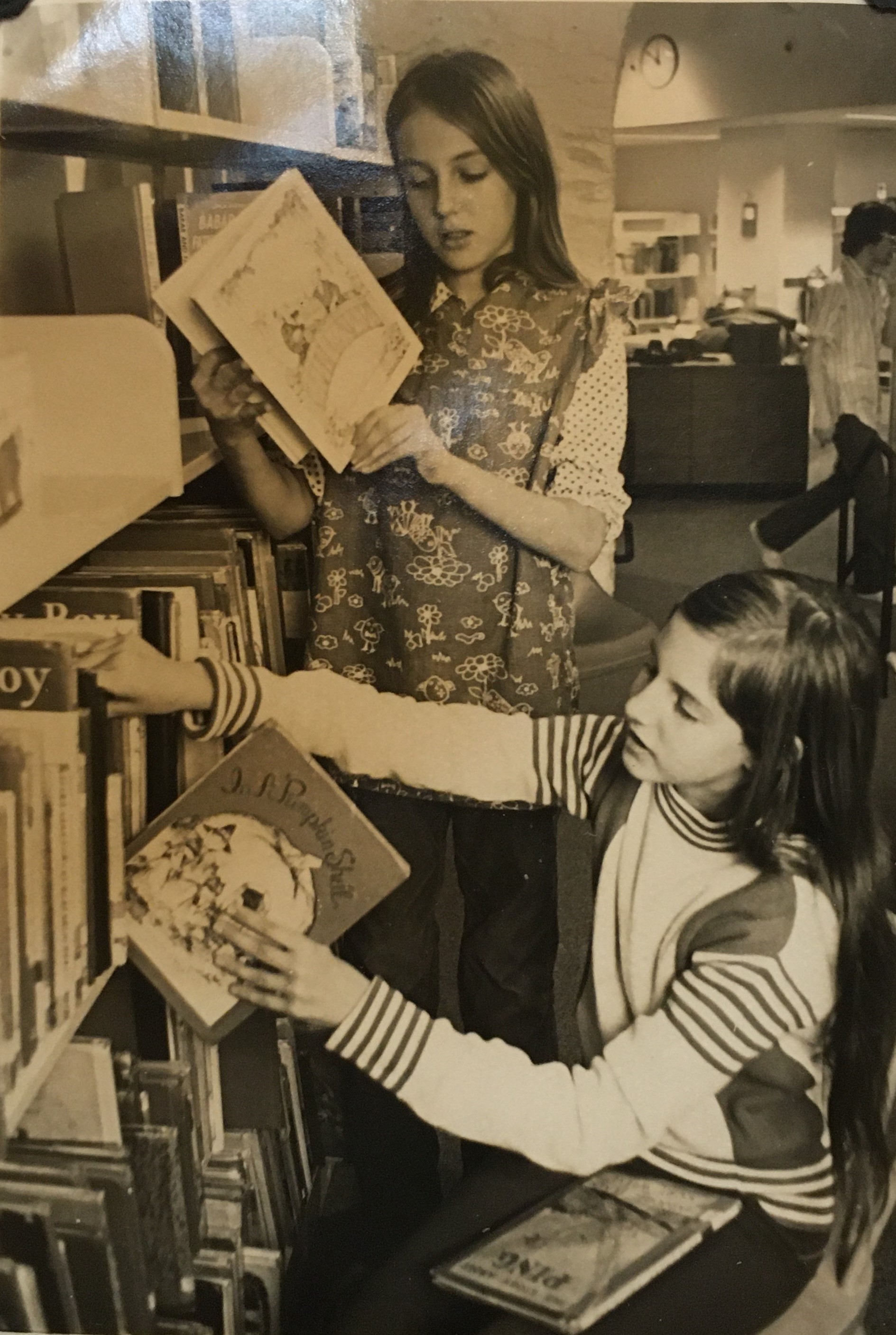
https://www.blackstonelibrary.org/jbml125/For this week’s 125th Anniversary fact we’re taking you back to the groovy days of the 1970s and one of our earliest renovation projects. It’s hard to imagine now, but there was a time when the Blackstone Library did not have a dedicated space for children. Recognizing the needs of the community, The Branford Woman’s Club teamed up with the library and began raising money in the early 1970s to change all that. They played an integral role in making the project happen, and Blackstone opened the brand-new Children’s Department in February of 1974!
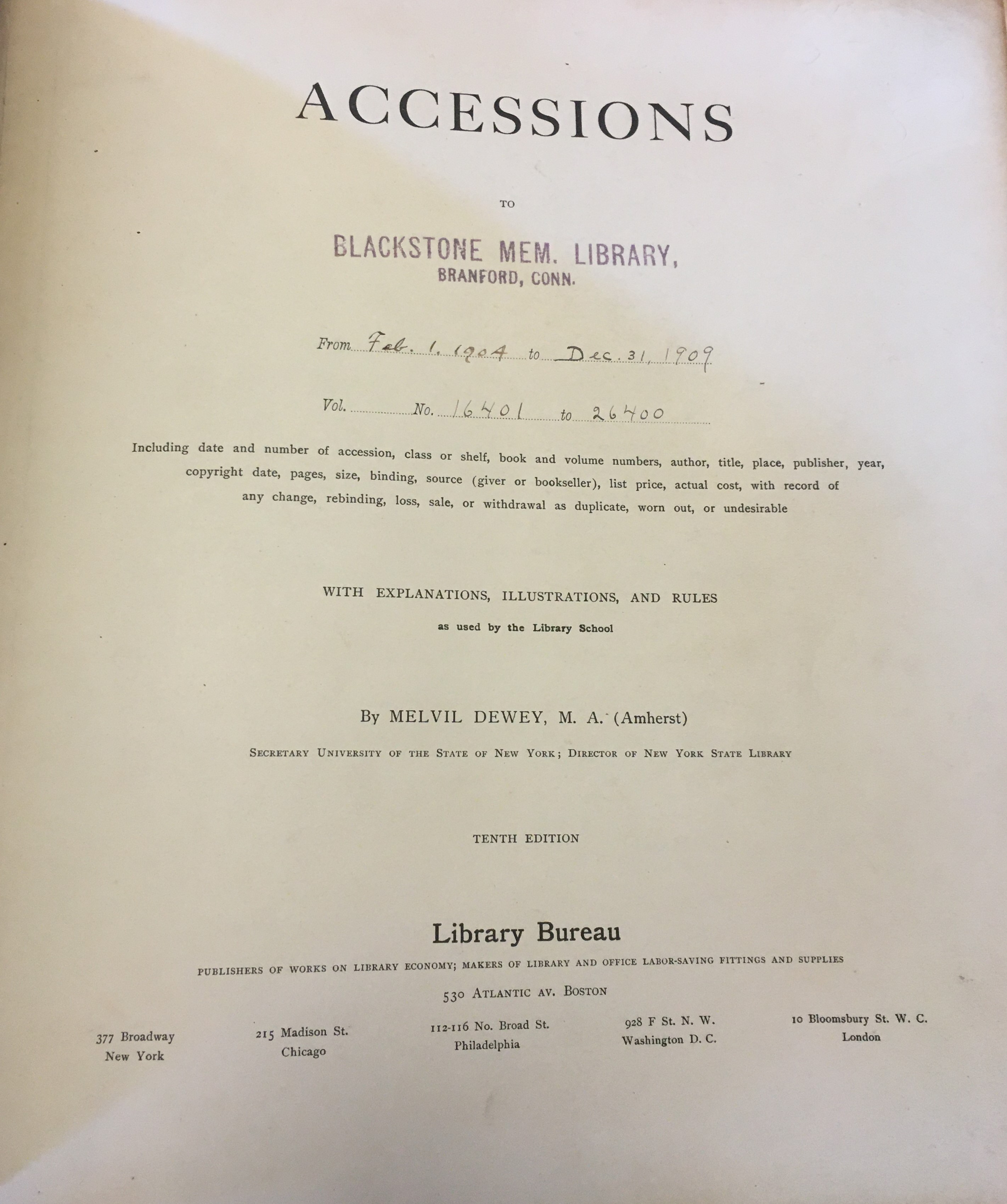
Today we’re sharing another library artifact that makes us thankful for computers! In our Blackstone Library archives we have a collection of original Accession Records dating from the earliest days of the Blackstone to approximately the 1940s. What exactly is an Accession Record? They’re massive hand-written ledgers of every book purchased for the library collection and include information on purchase dates, prices paid, publication information, and even when the book was eventually removed from the collection–known as Condemning according to the stamp that was used at the time. These ledger books were specially designed by Melville Dewey (of Dewey Decimal fame) and include a handy list of standardized abbreviations to help save time and space. These books are a real gem of library history, but we think we’ll stick with our computerized catalog!
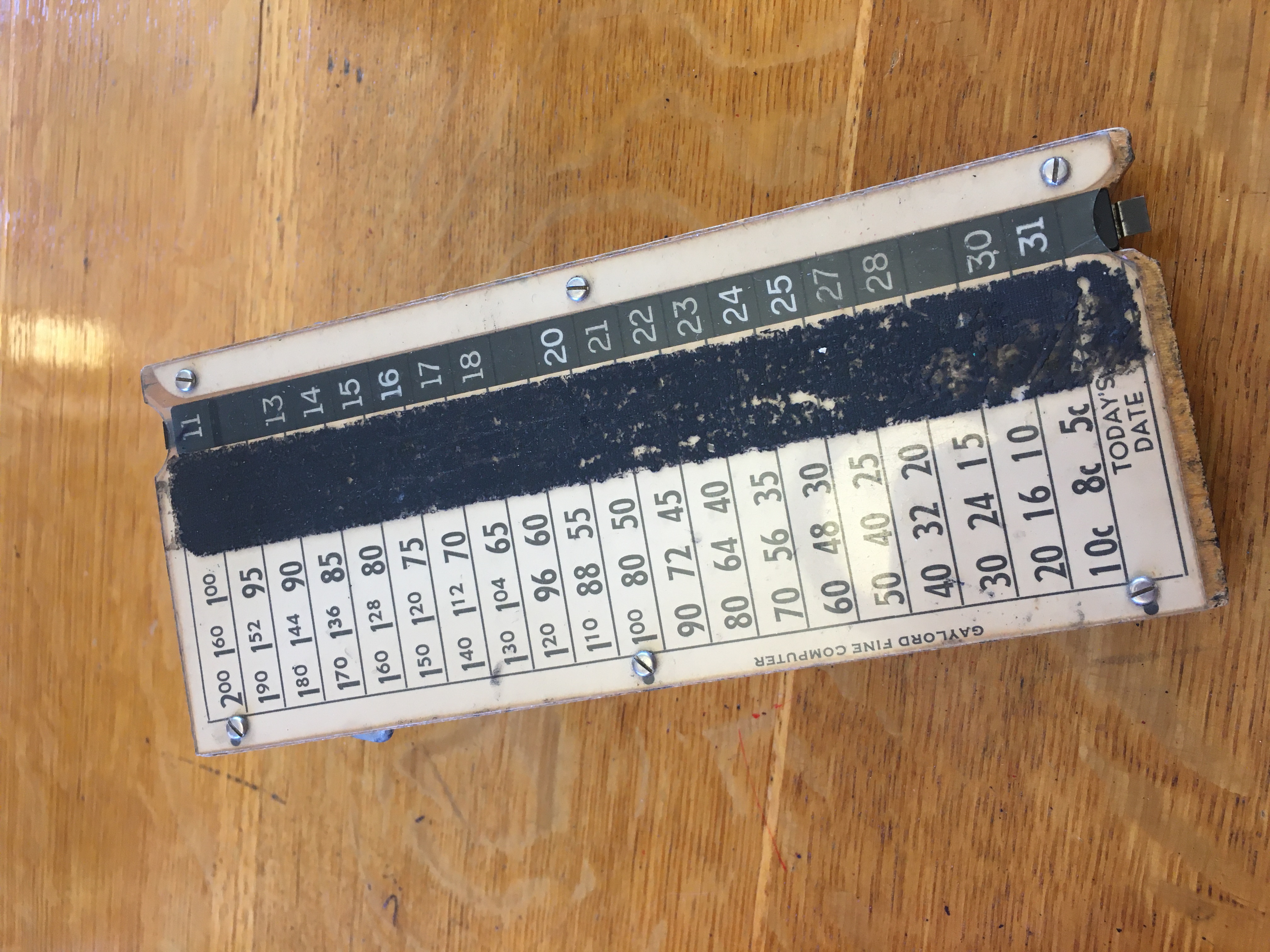
Fines may be long gone here at the Blackstone Library, but today we’re sharing an artifact from library fine history. This Fine Calculator was found in our library archives and probably dates from around the 1940s or 50s. It was designed to help librarians calculate fines accurately before the days of computers and calculators. You can check out our Facebook Page to learn all about how it works. Thankfully, for us and for you, we at the Blackstone won’t be needing this device any time soon!
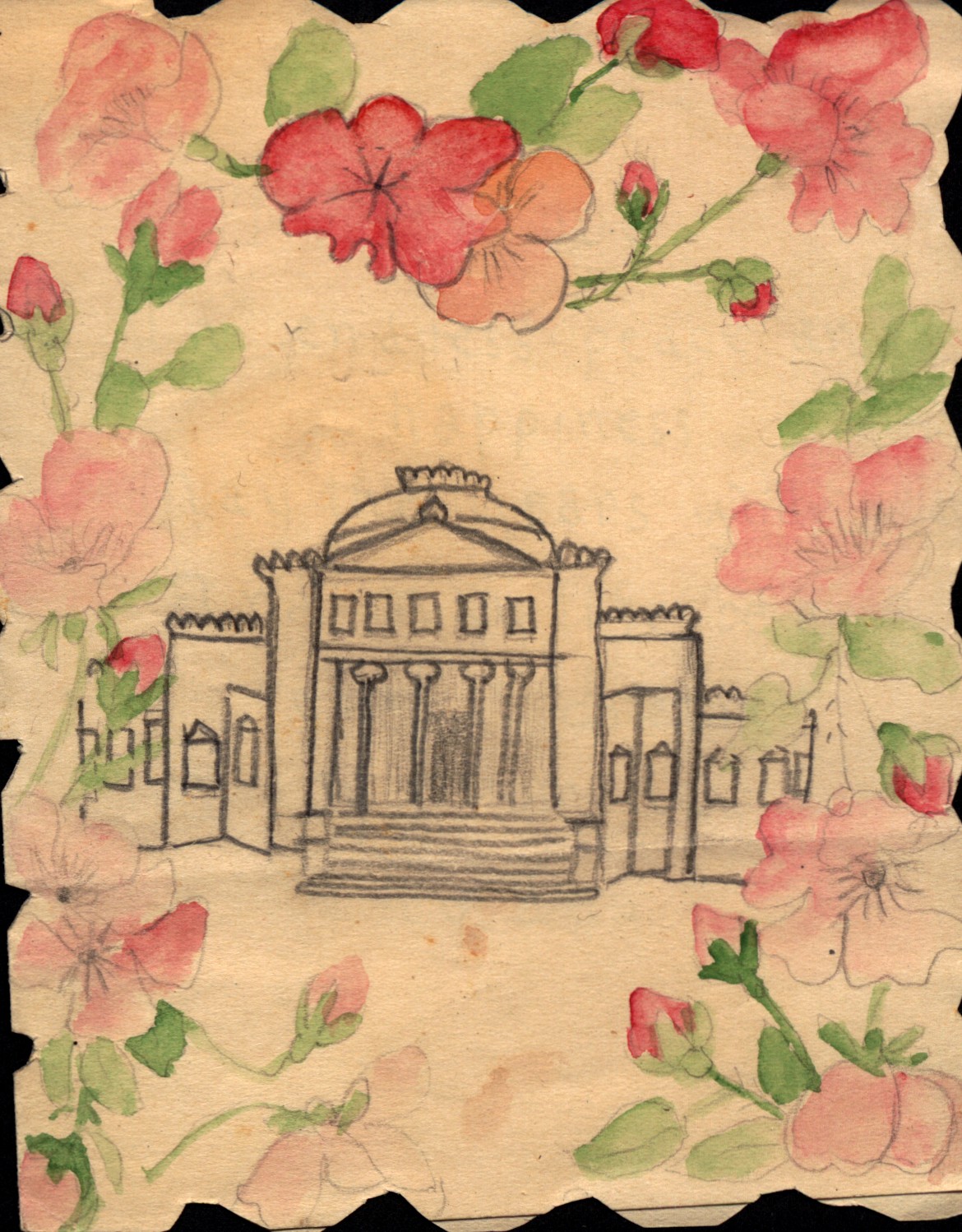
Everyone in Branford knows the Blackstone Library is an impressive piece of architecture. One of our favorite things to see are artistic renderings of the building from both professionals and amateurs alike! Today we’re featuring this card from our archives featuring a beautifully detailed drawing of the library. The card is from 1906 and was done by a woman named Martina Meline. She also included a lovely poem on the inside, so be sure to check out our Facebook page to read it!
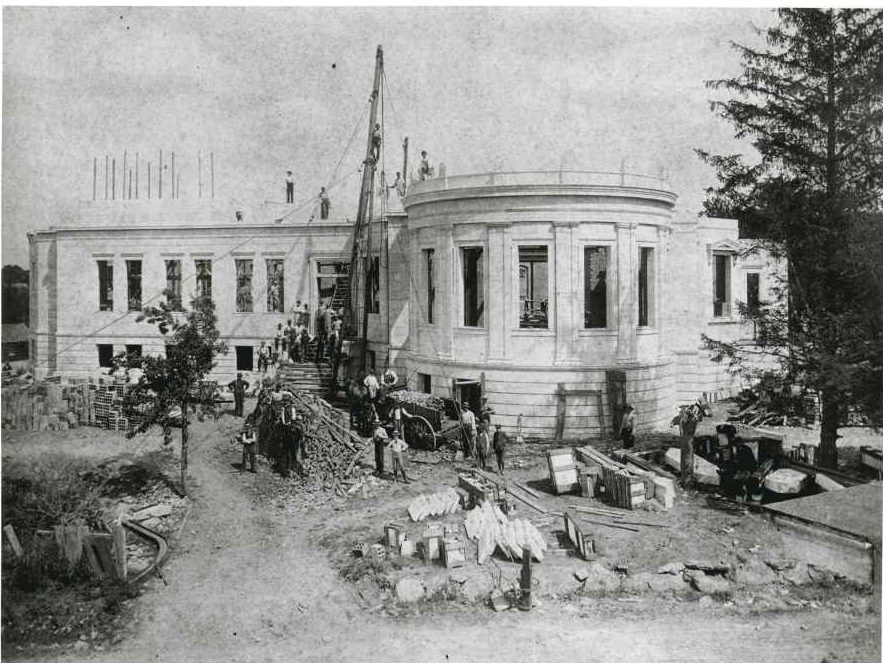
| The library was dedicated on June 17, 1896 and opened the next day, after three years of construction. You can read the architect’s description of the building and the bronze doors and the artist’s description of the paintings in the dome. | 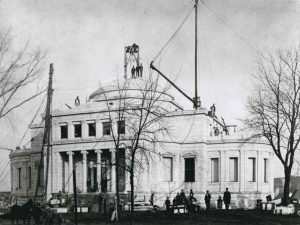 |
